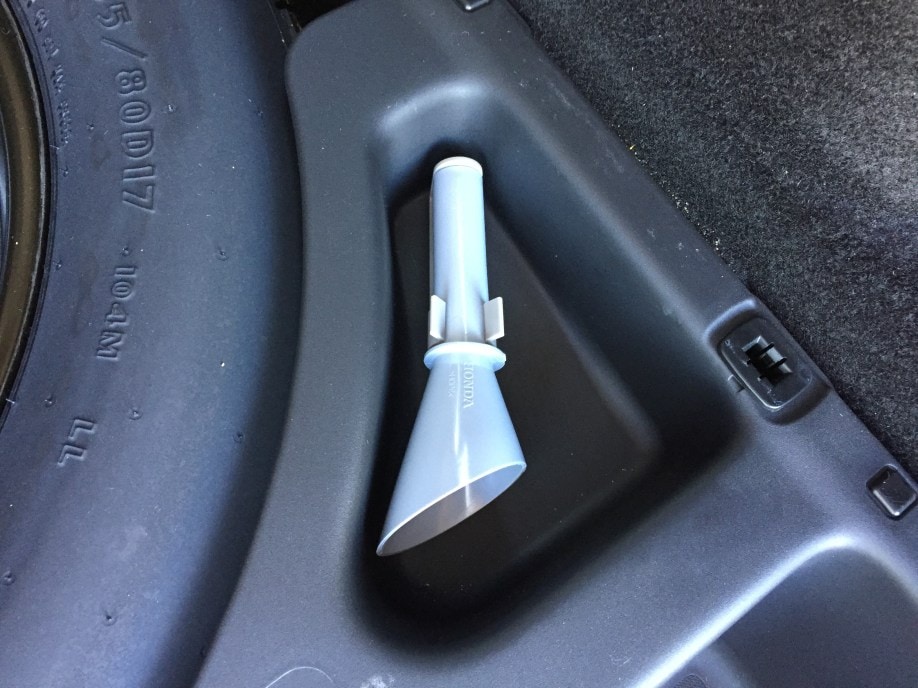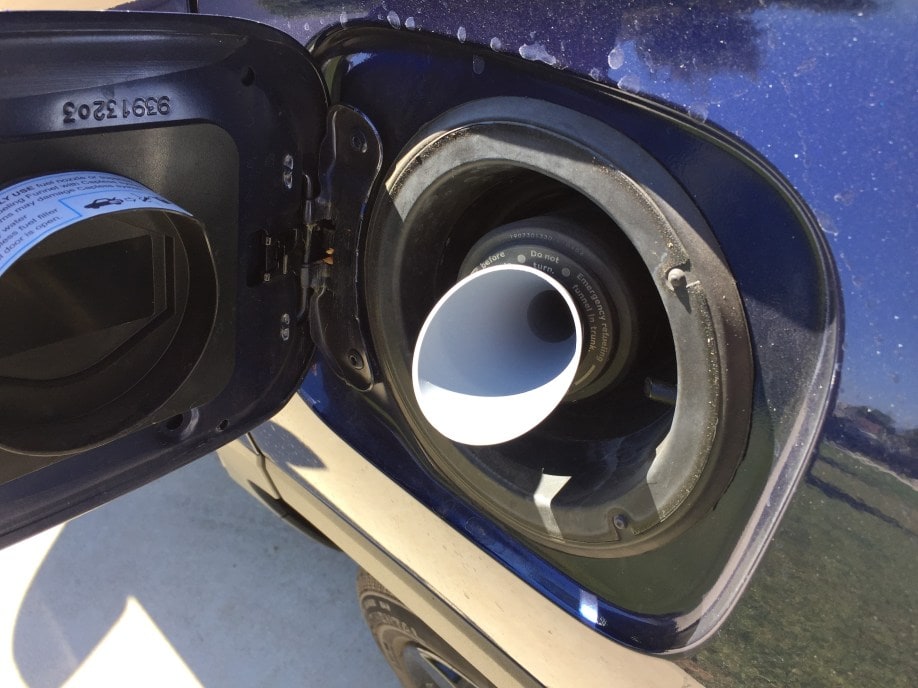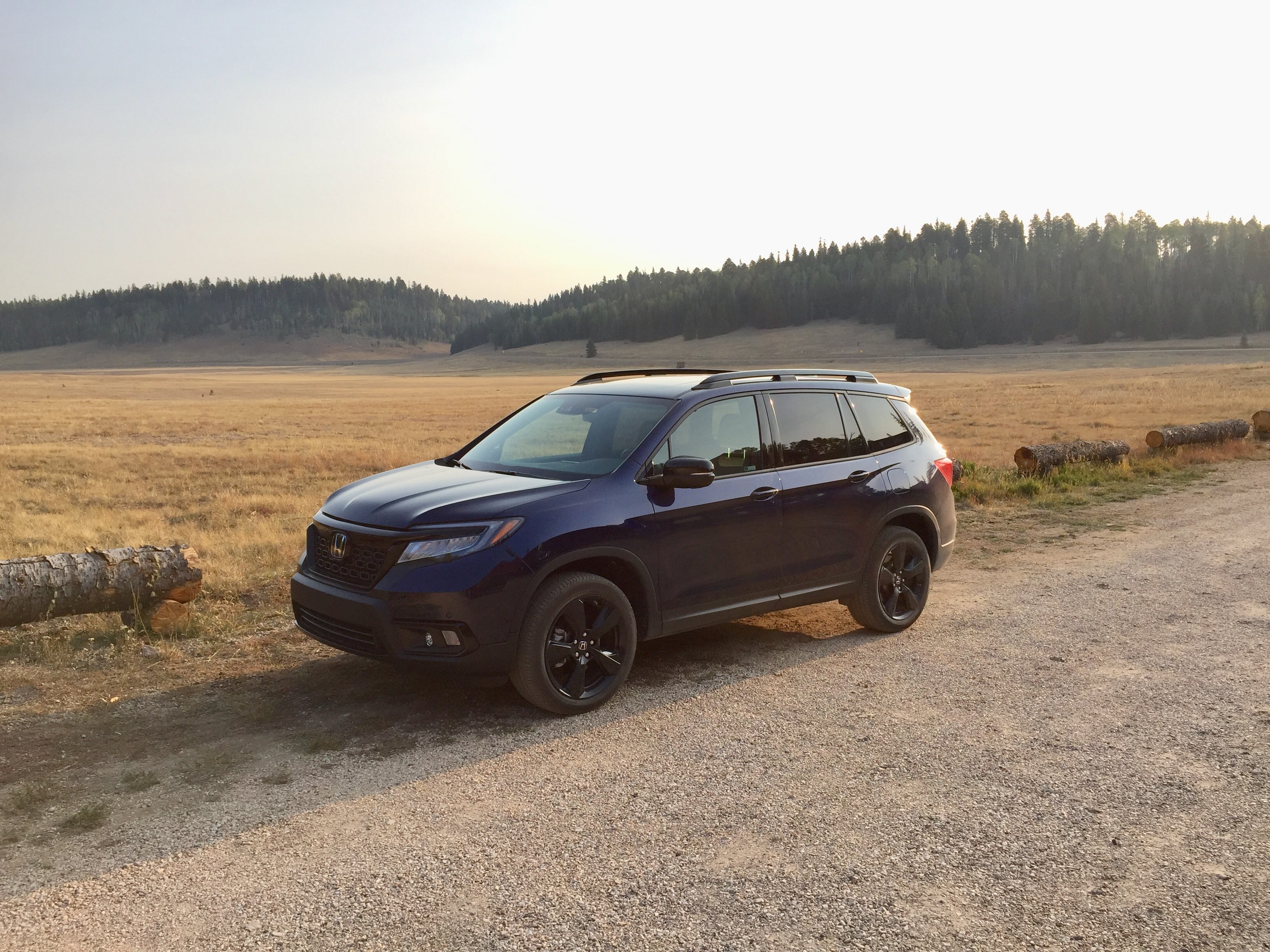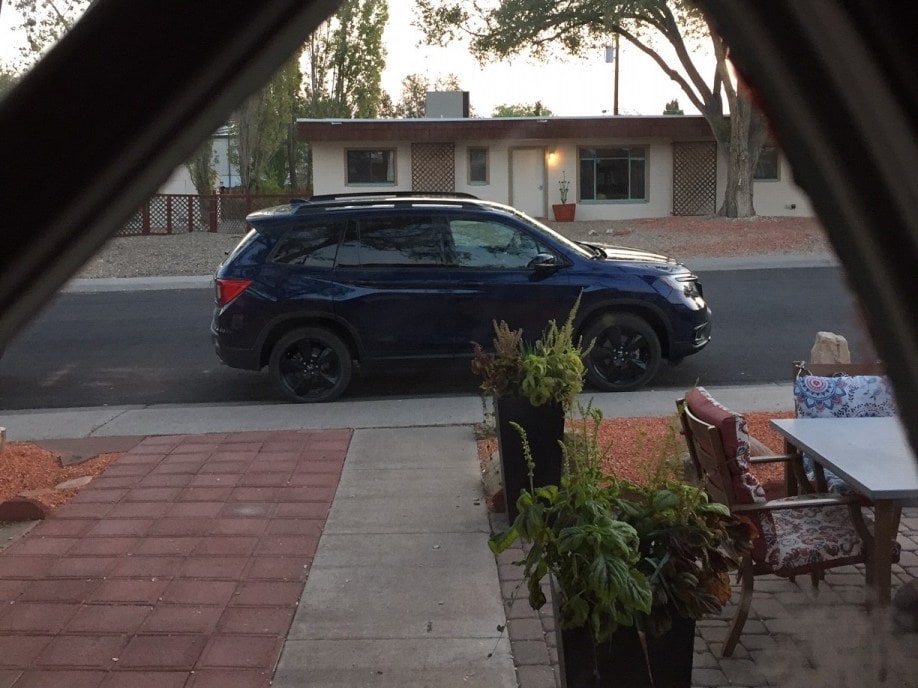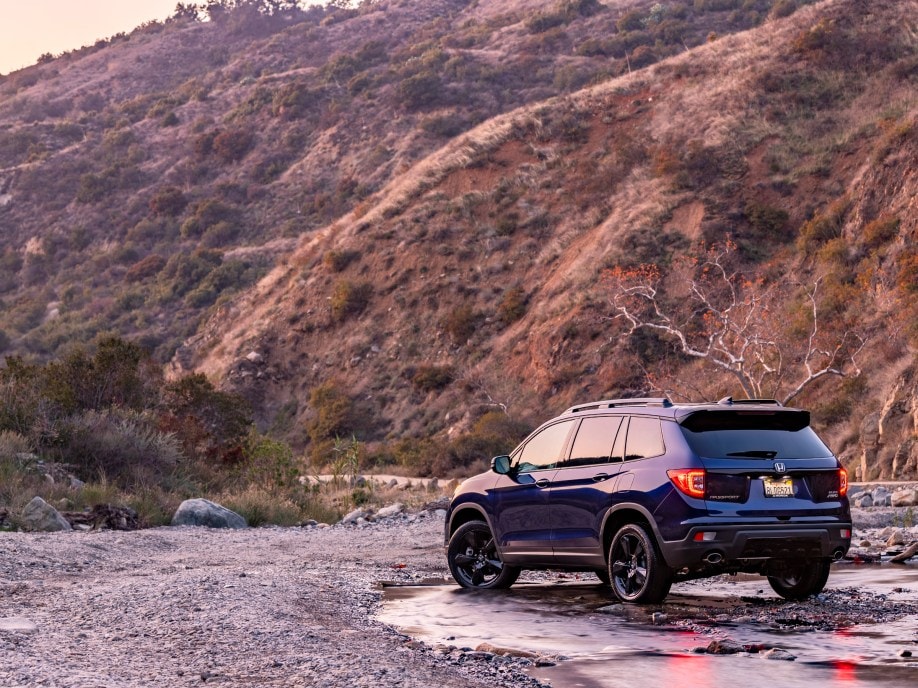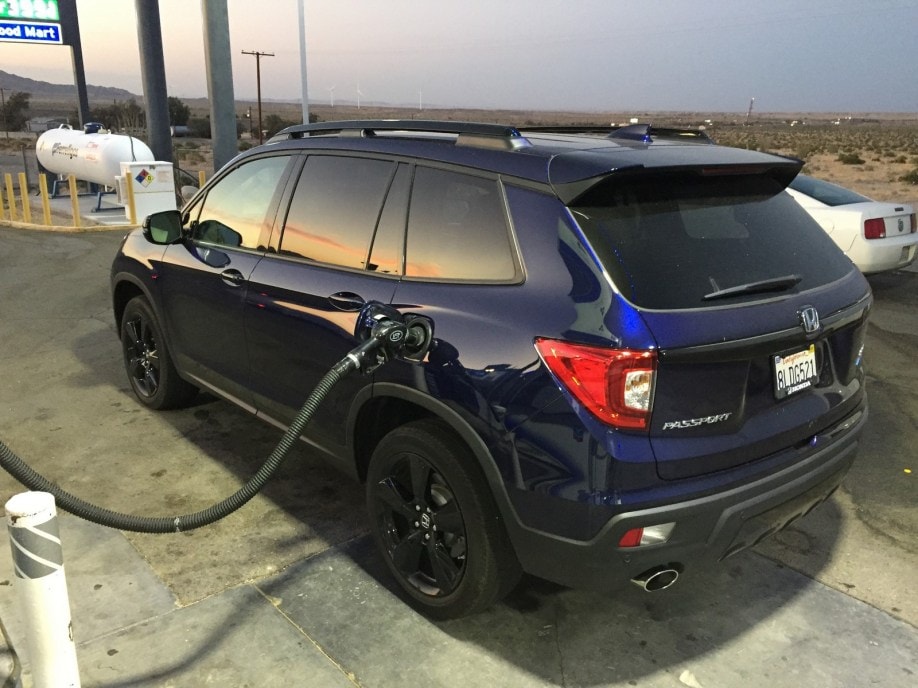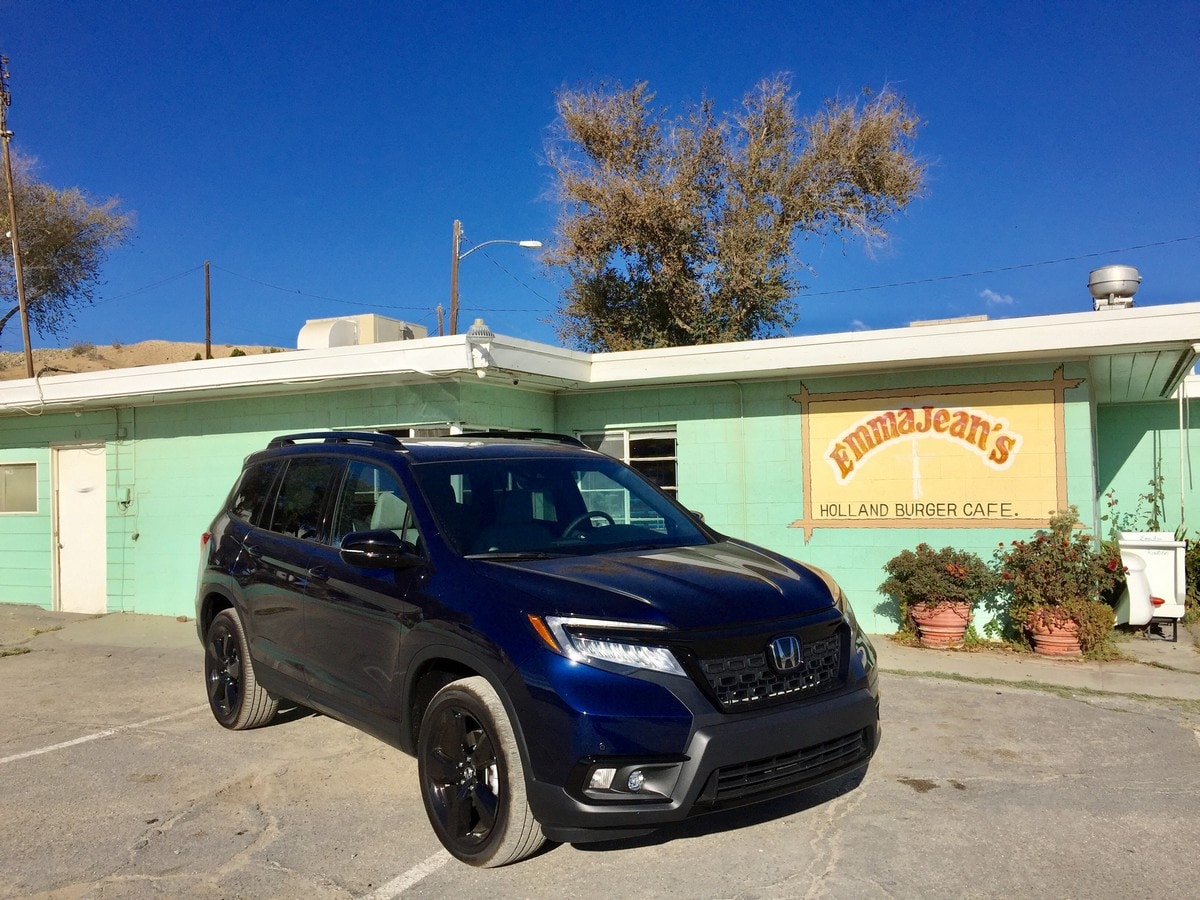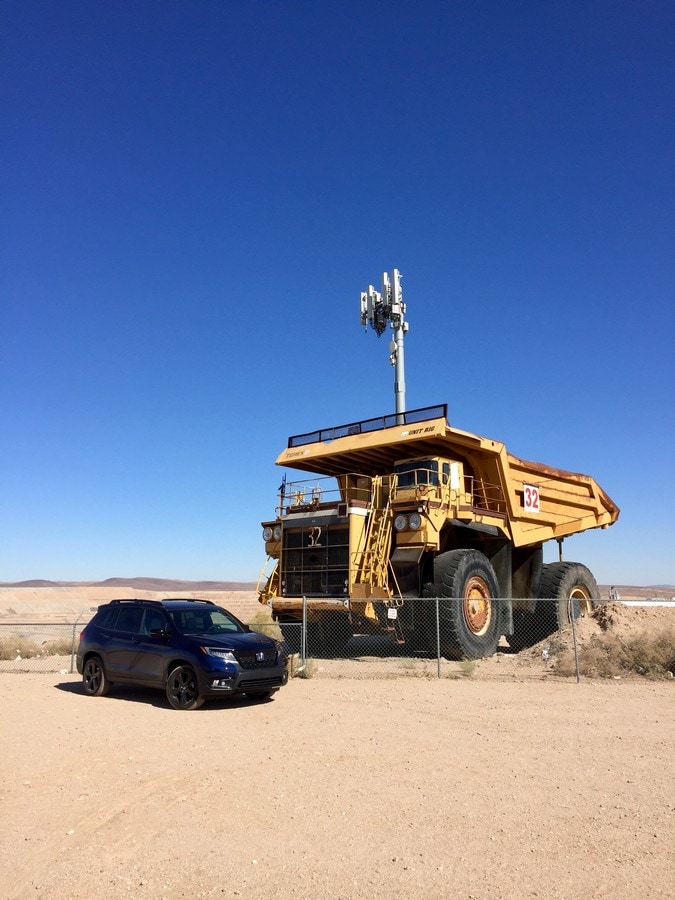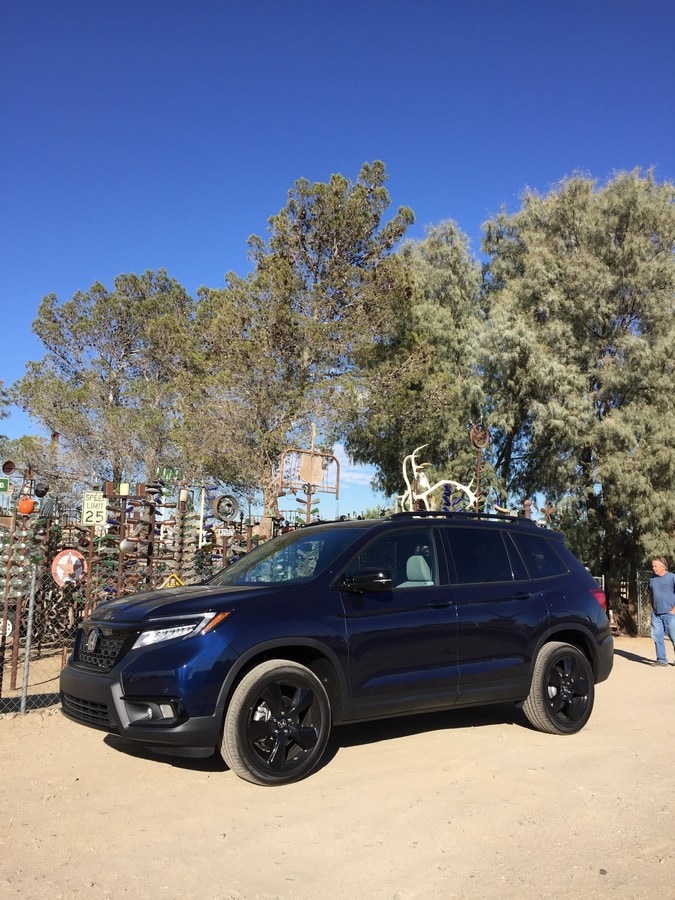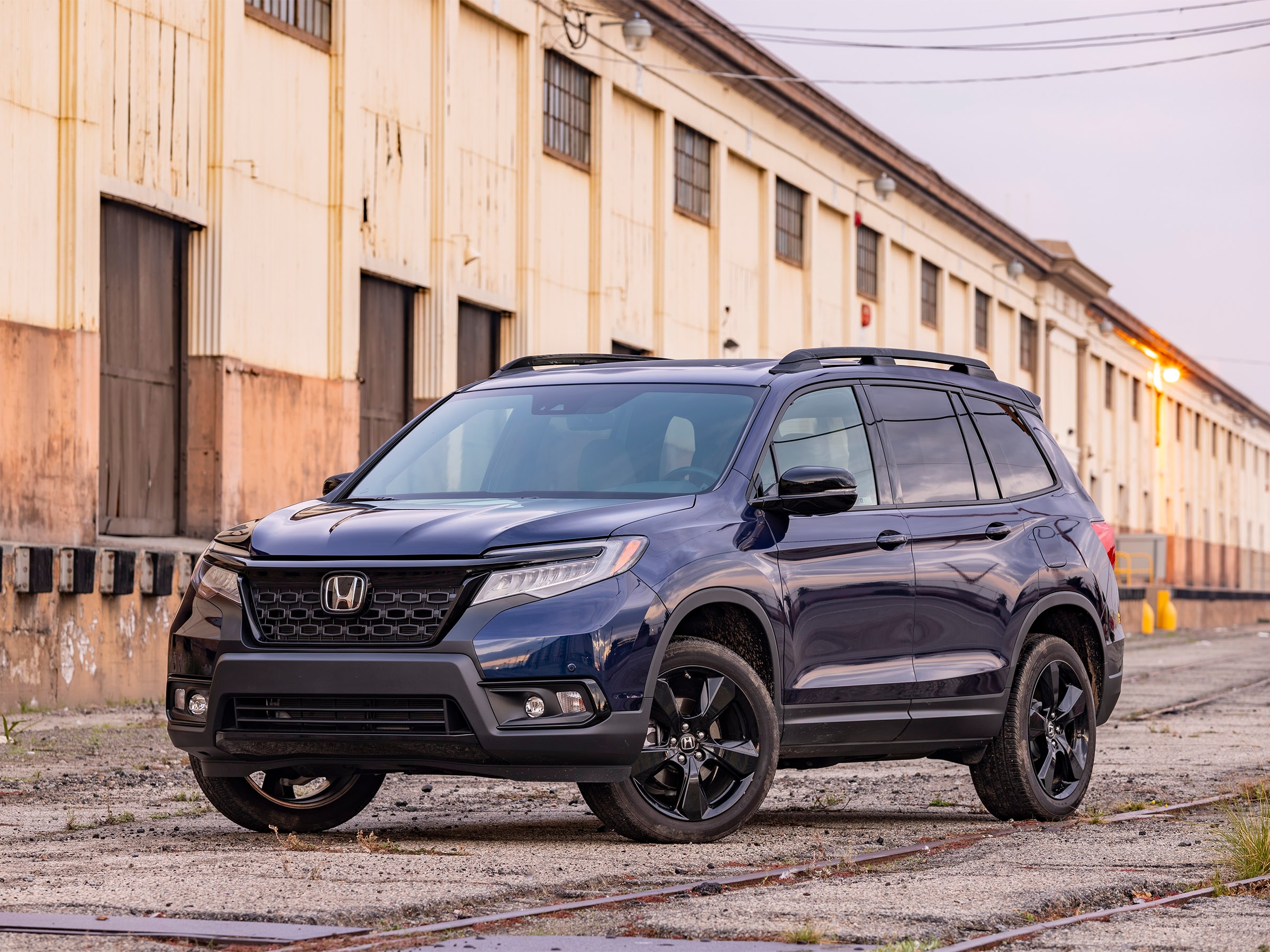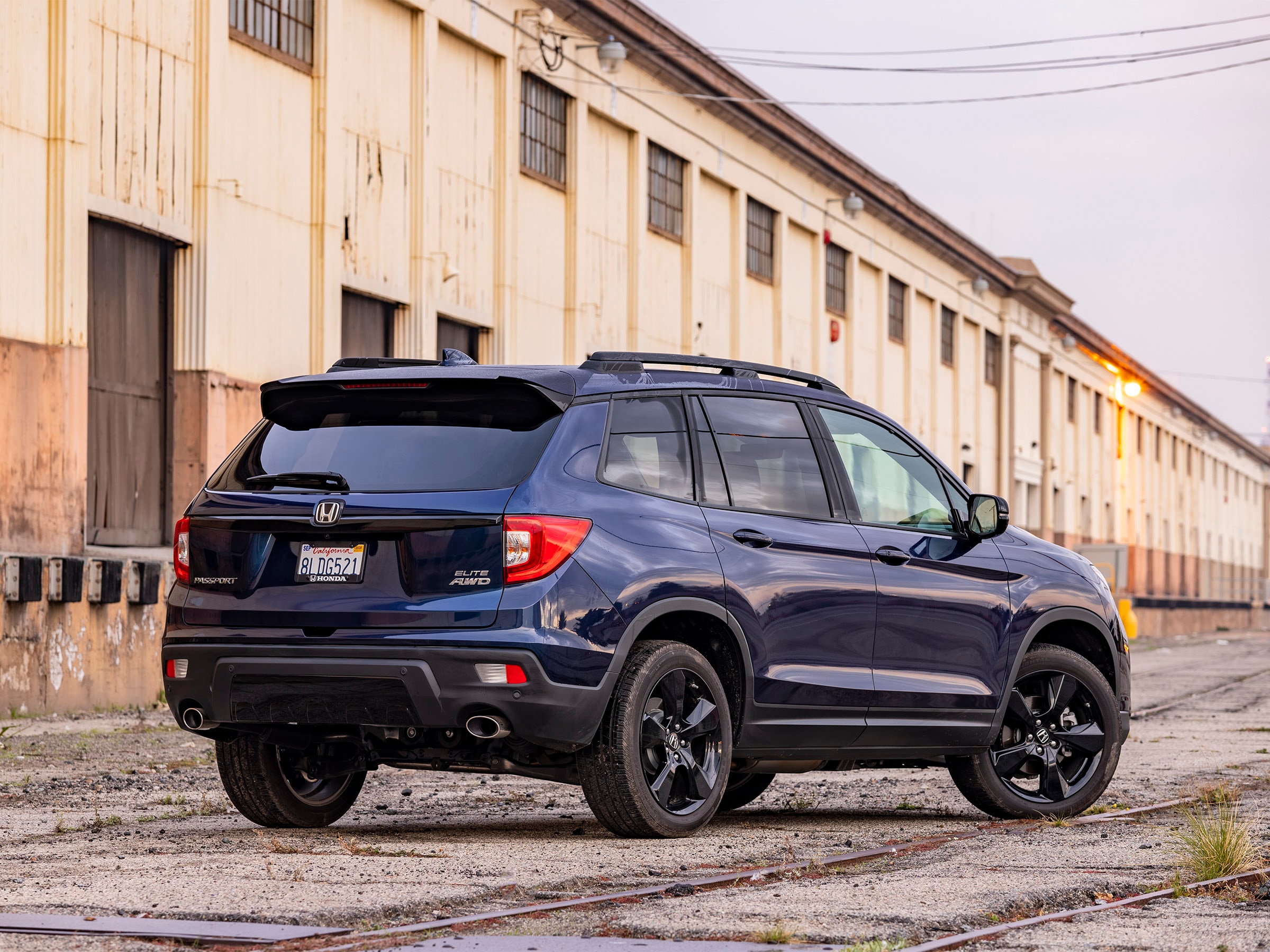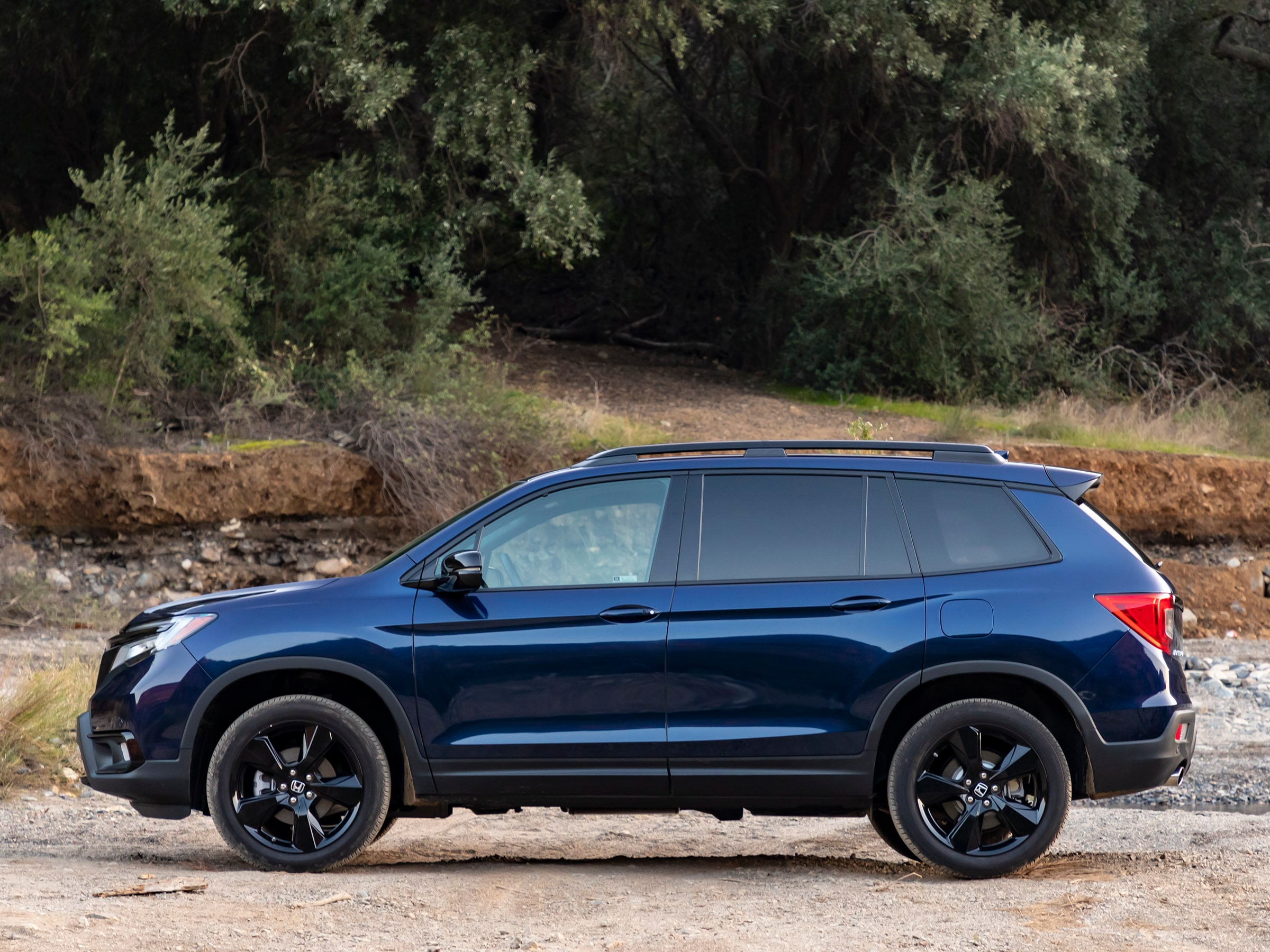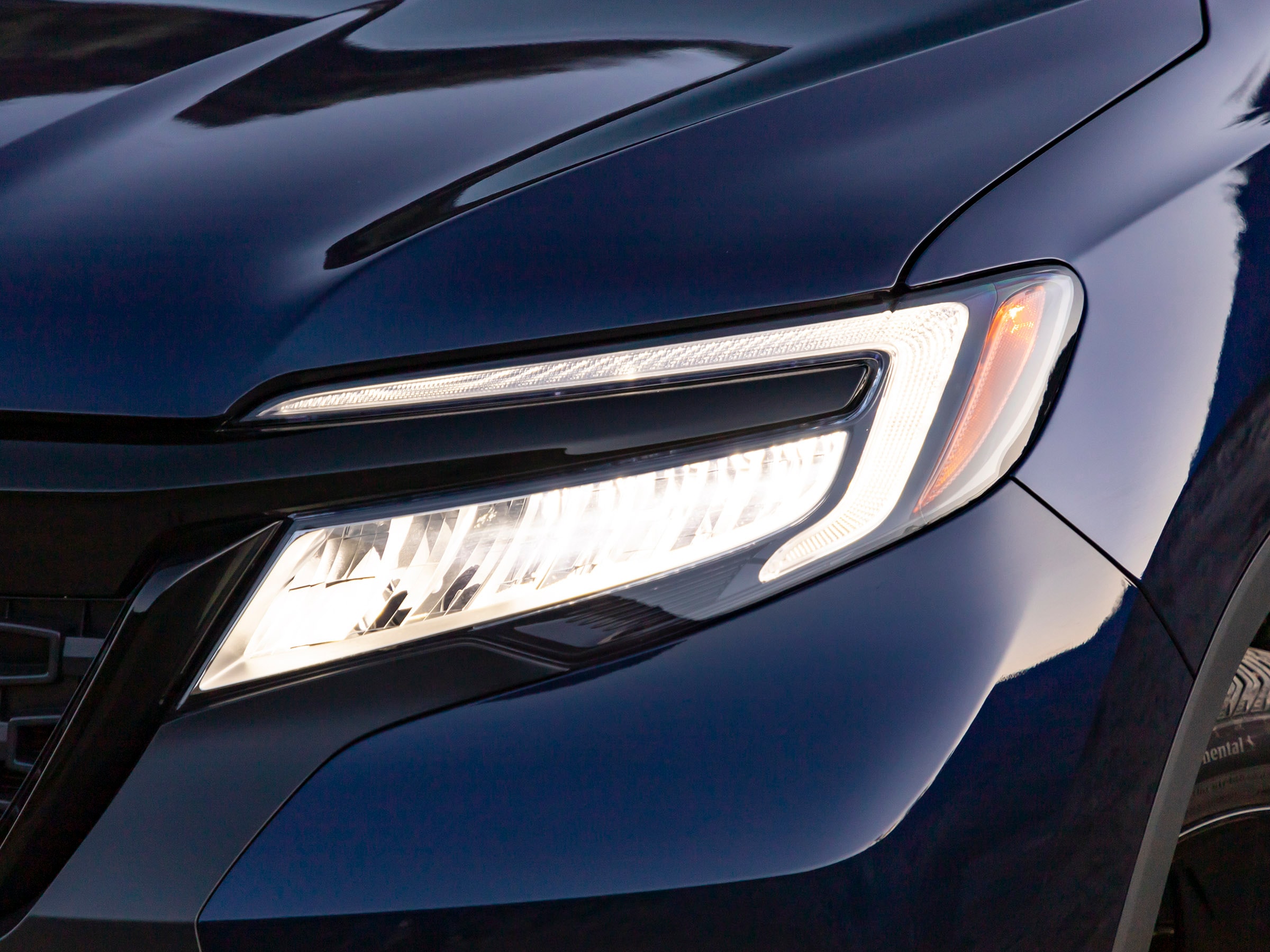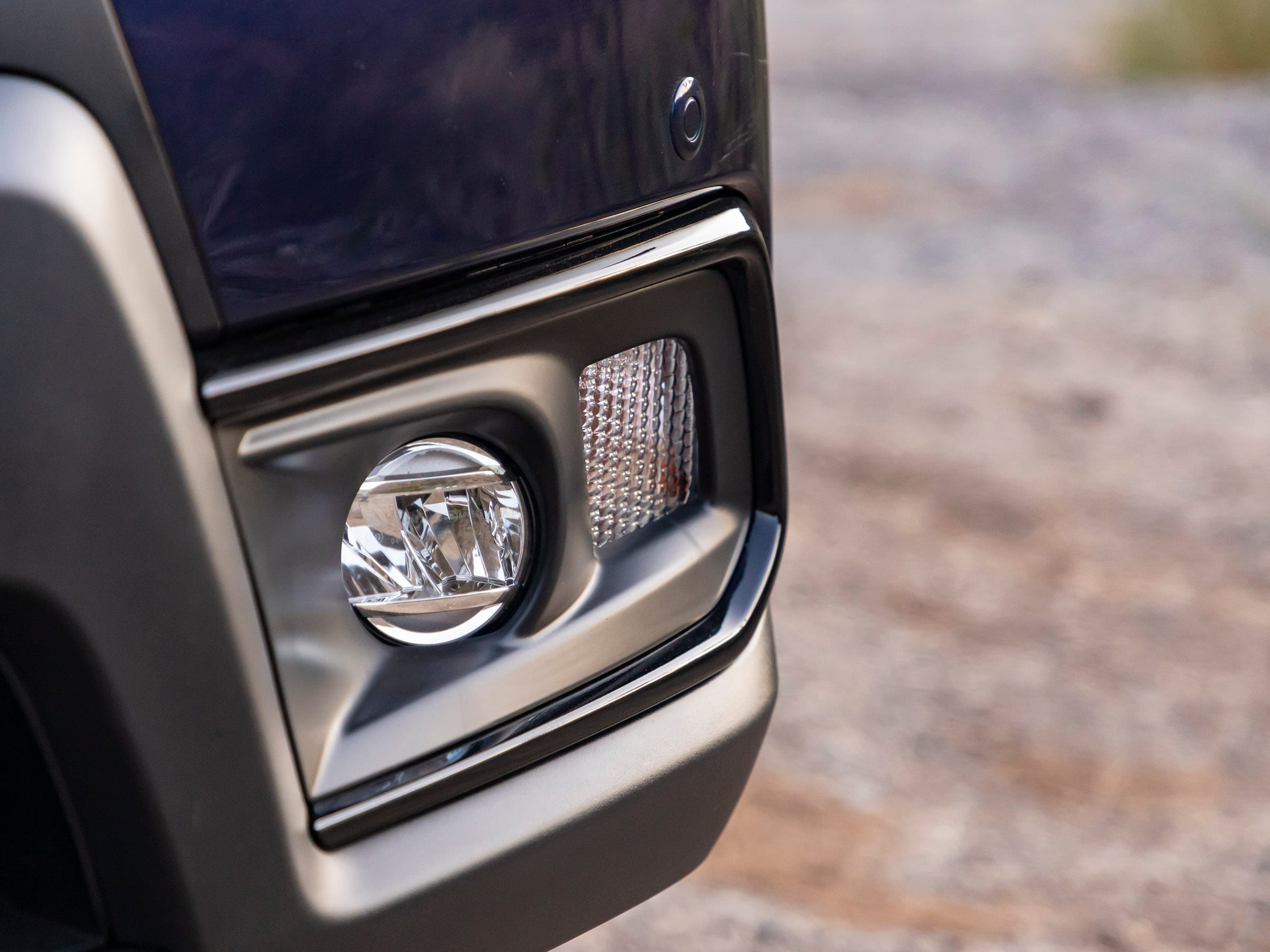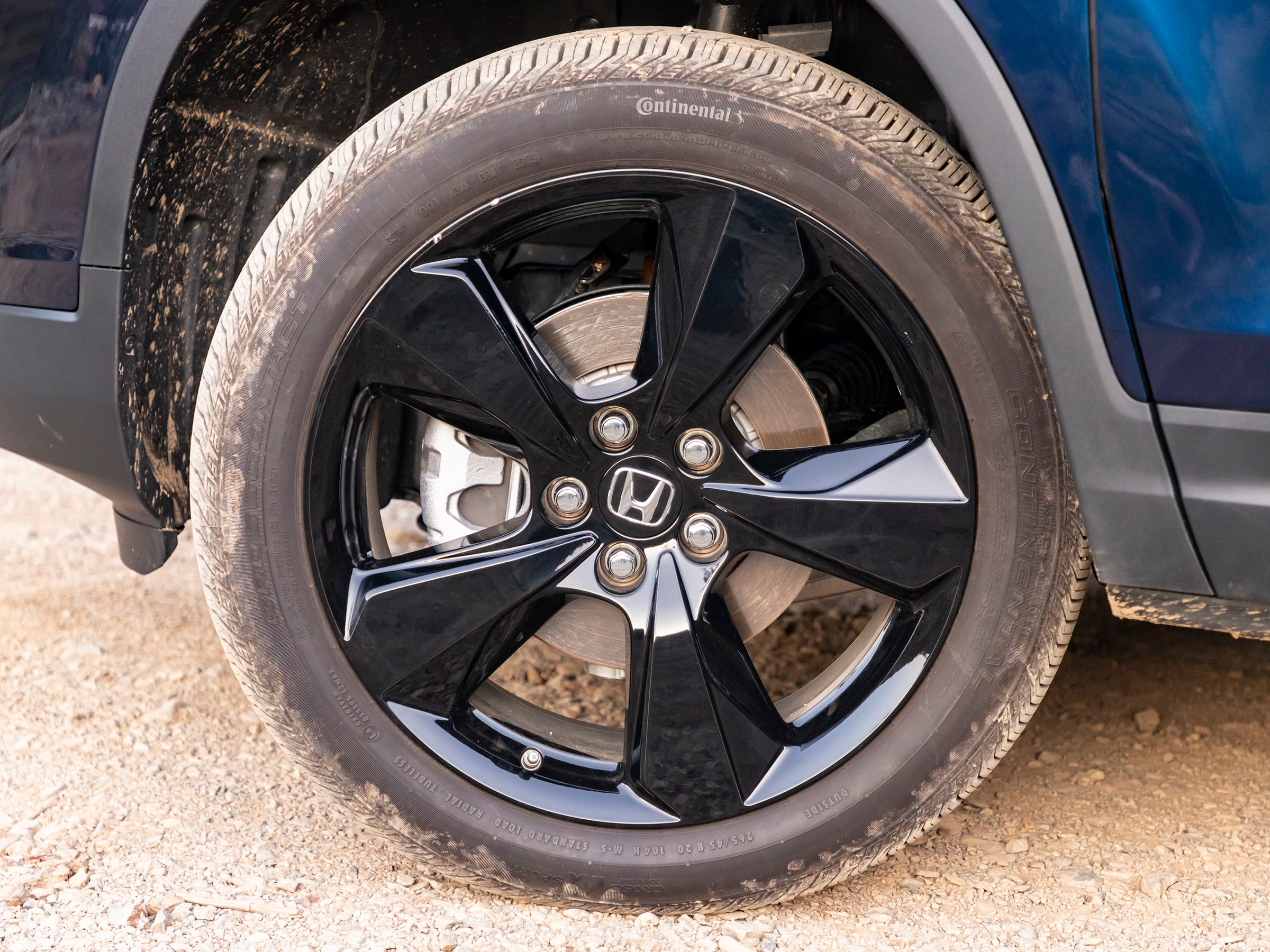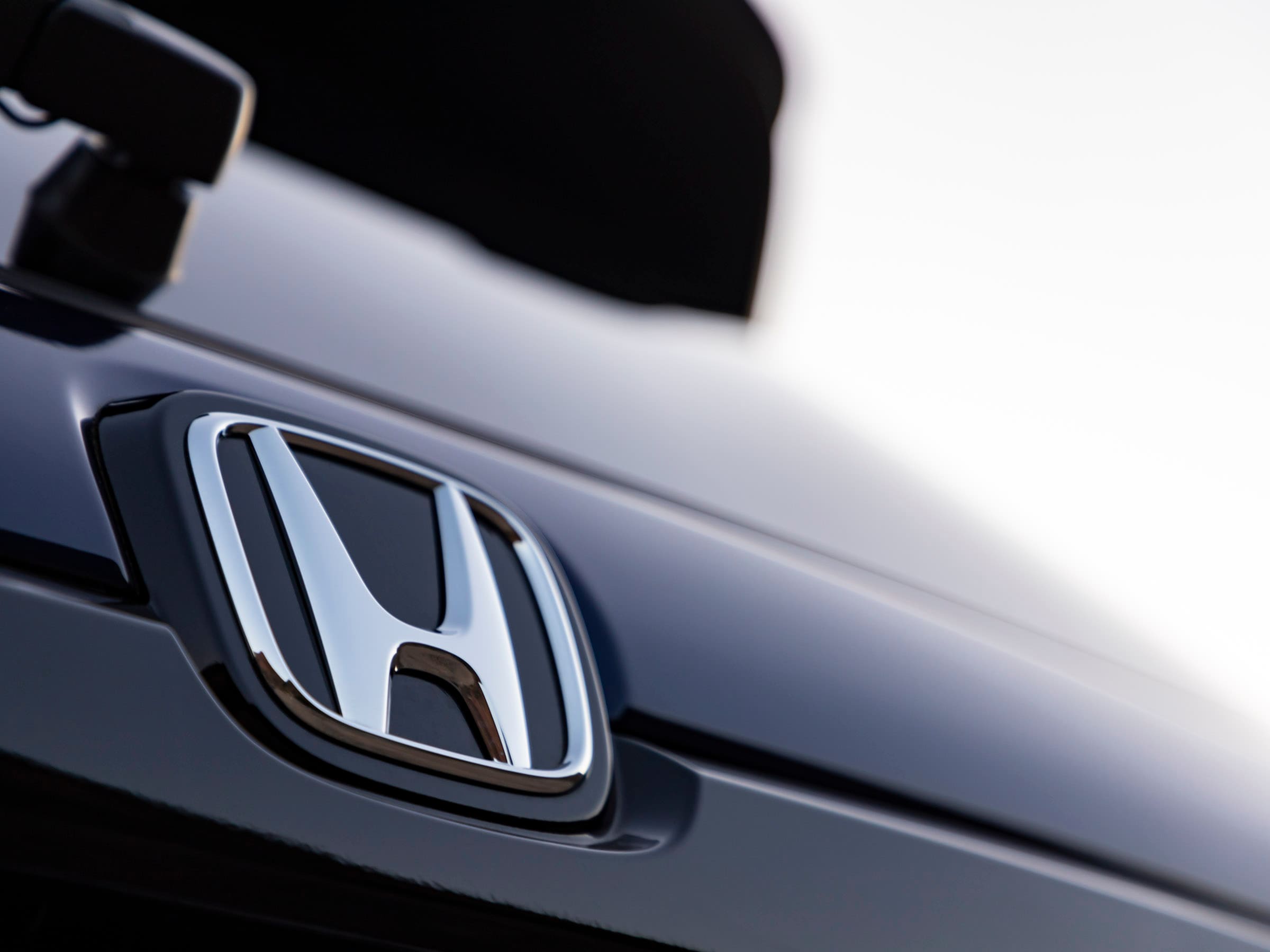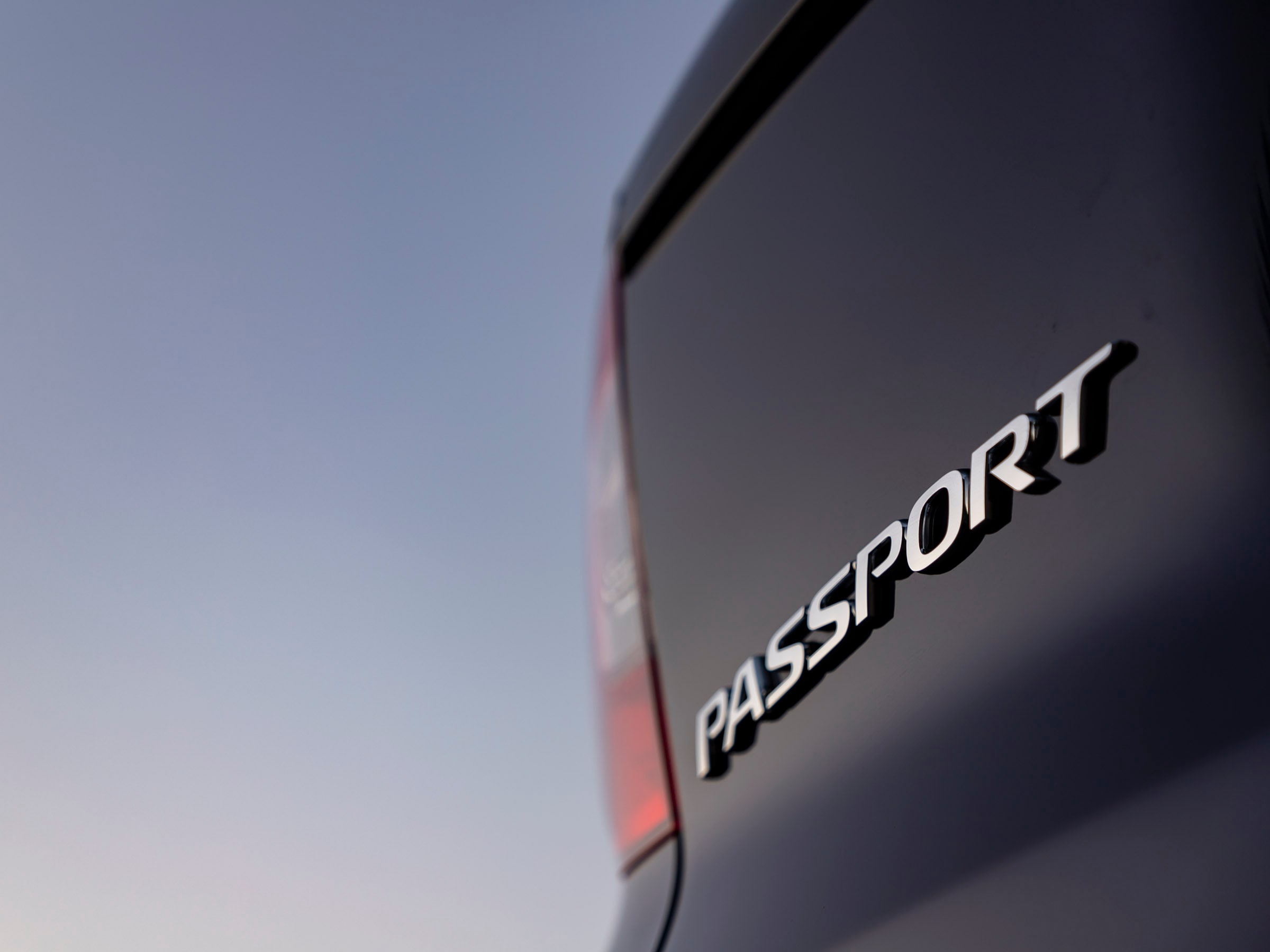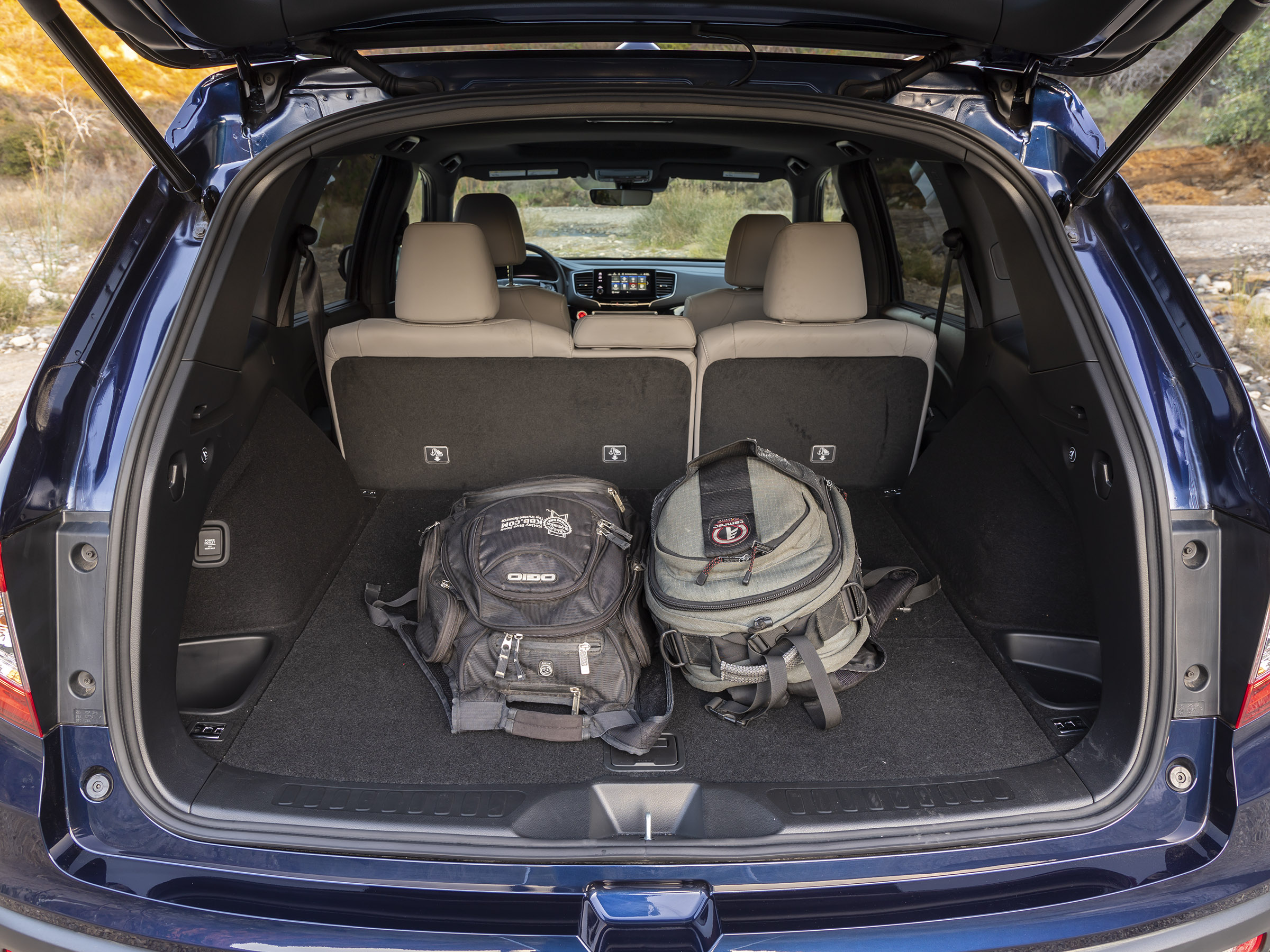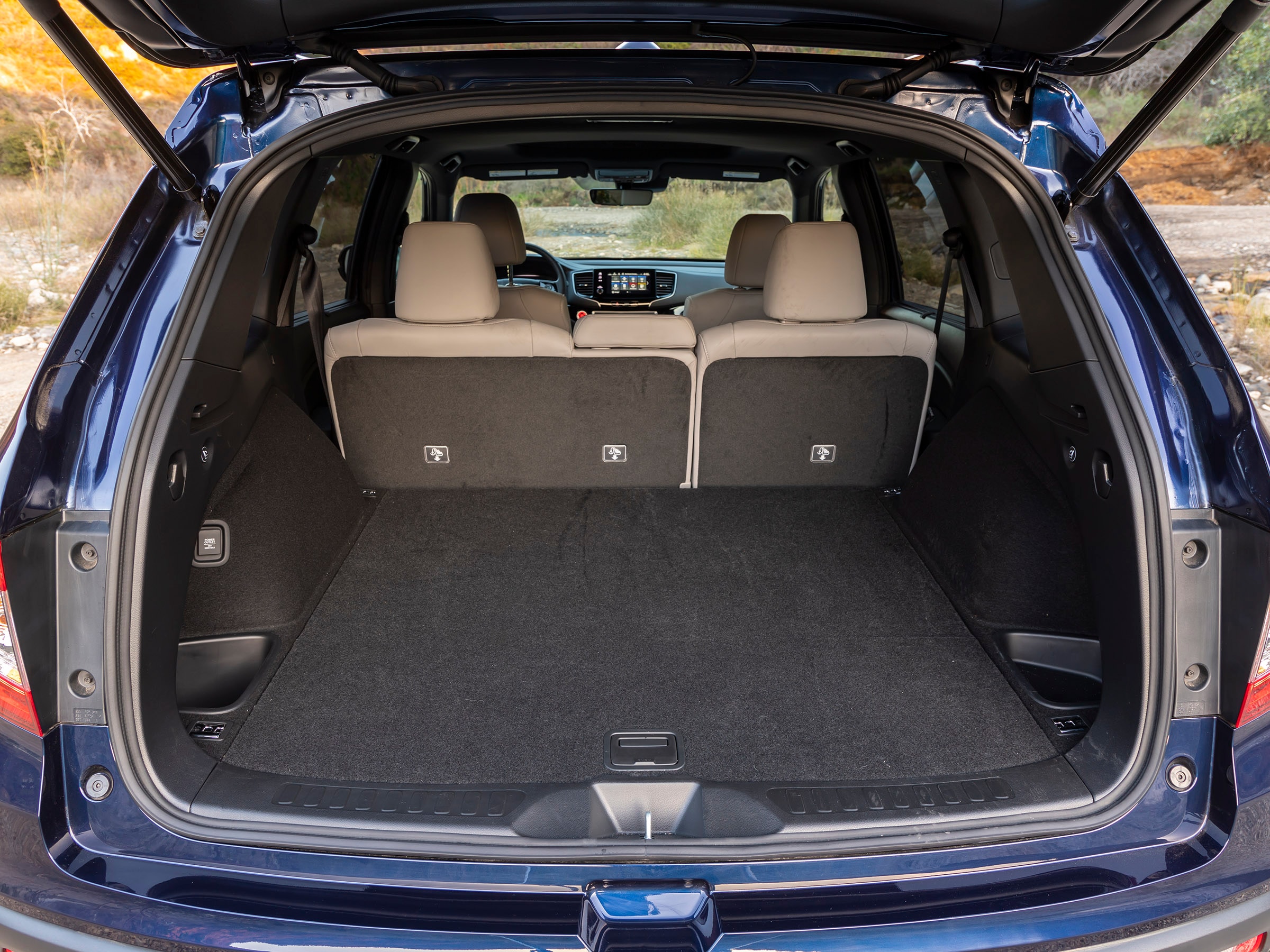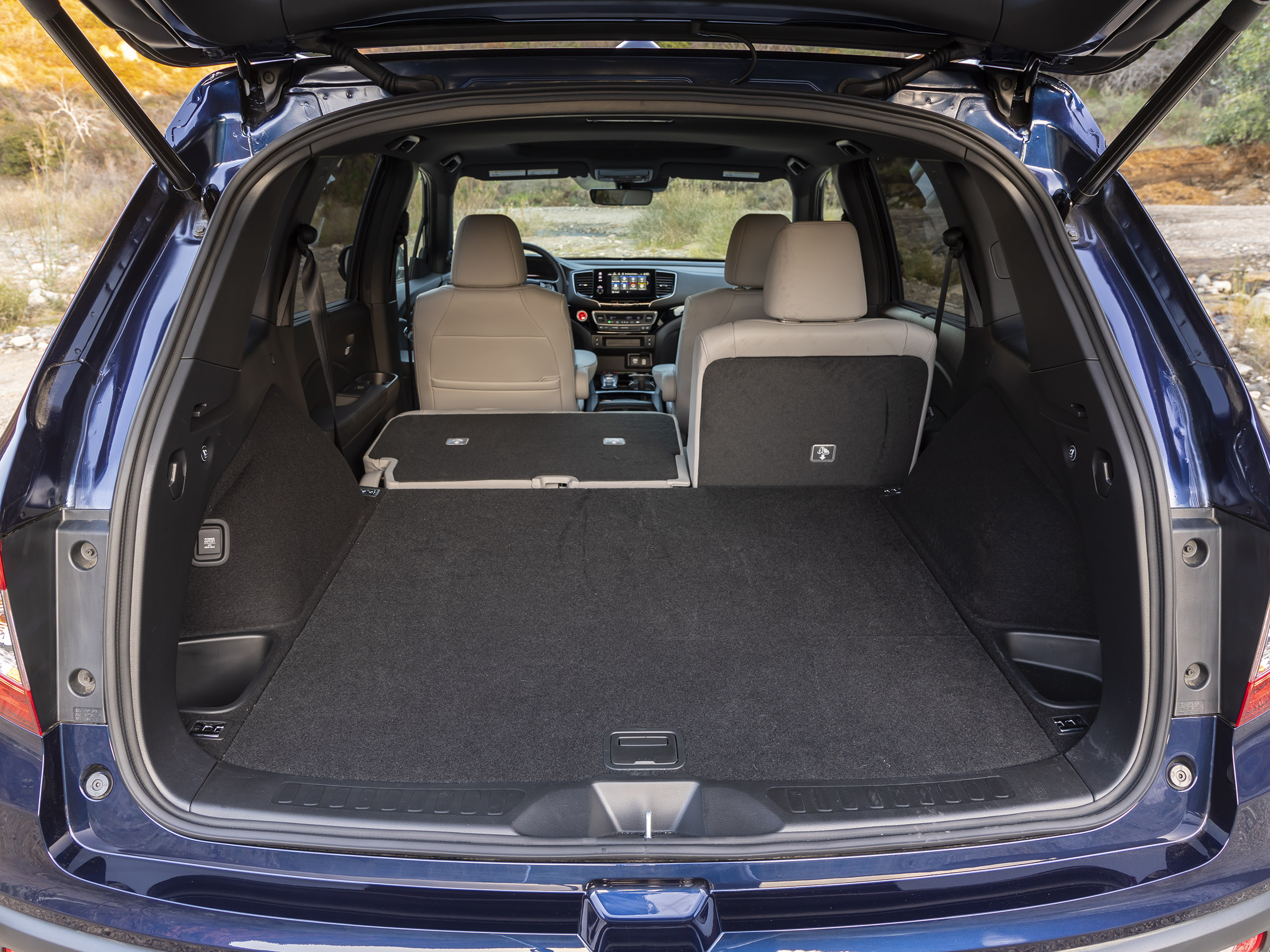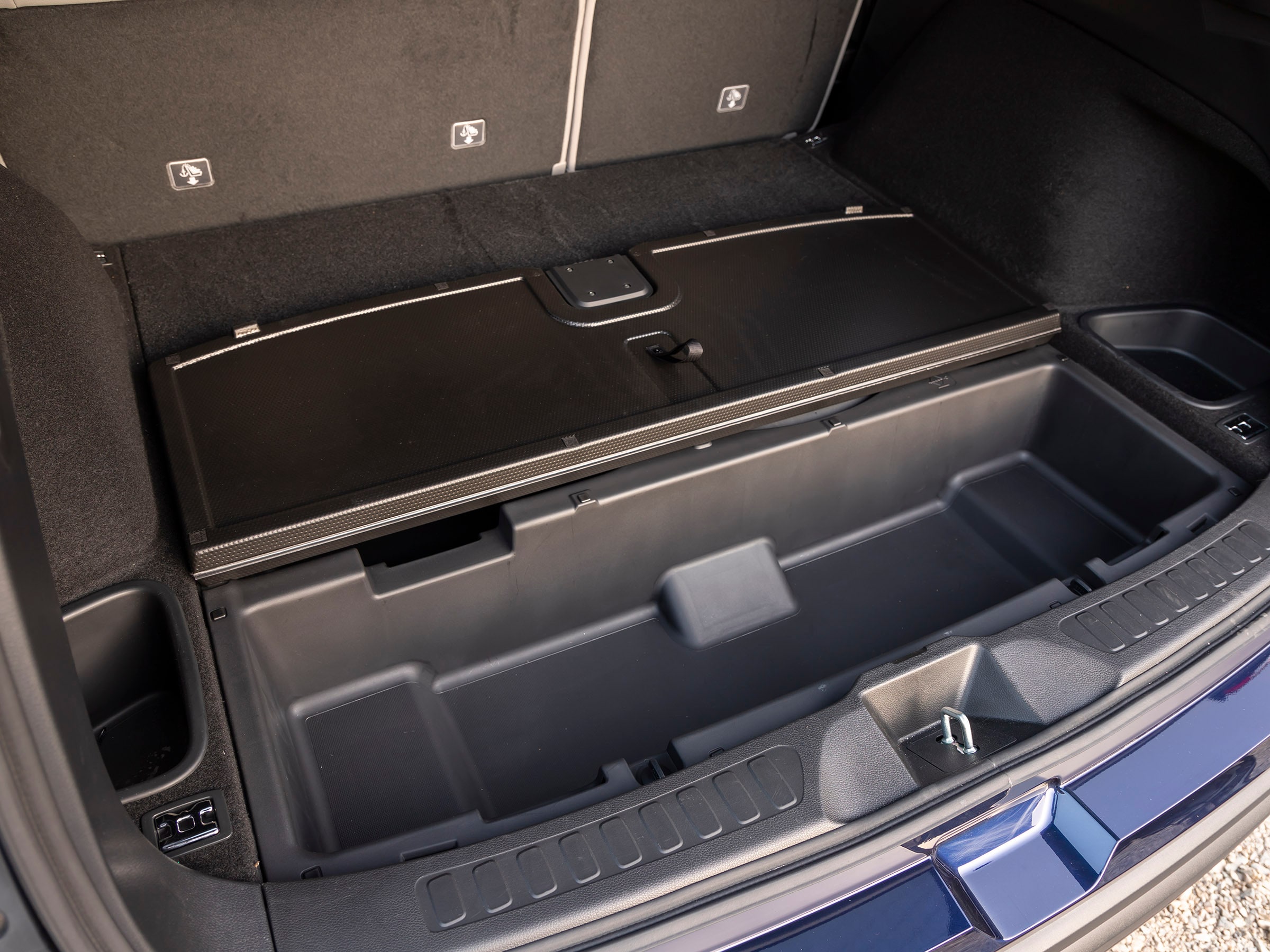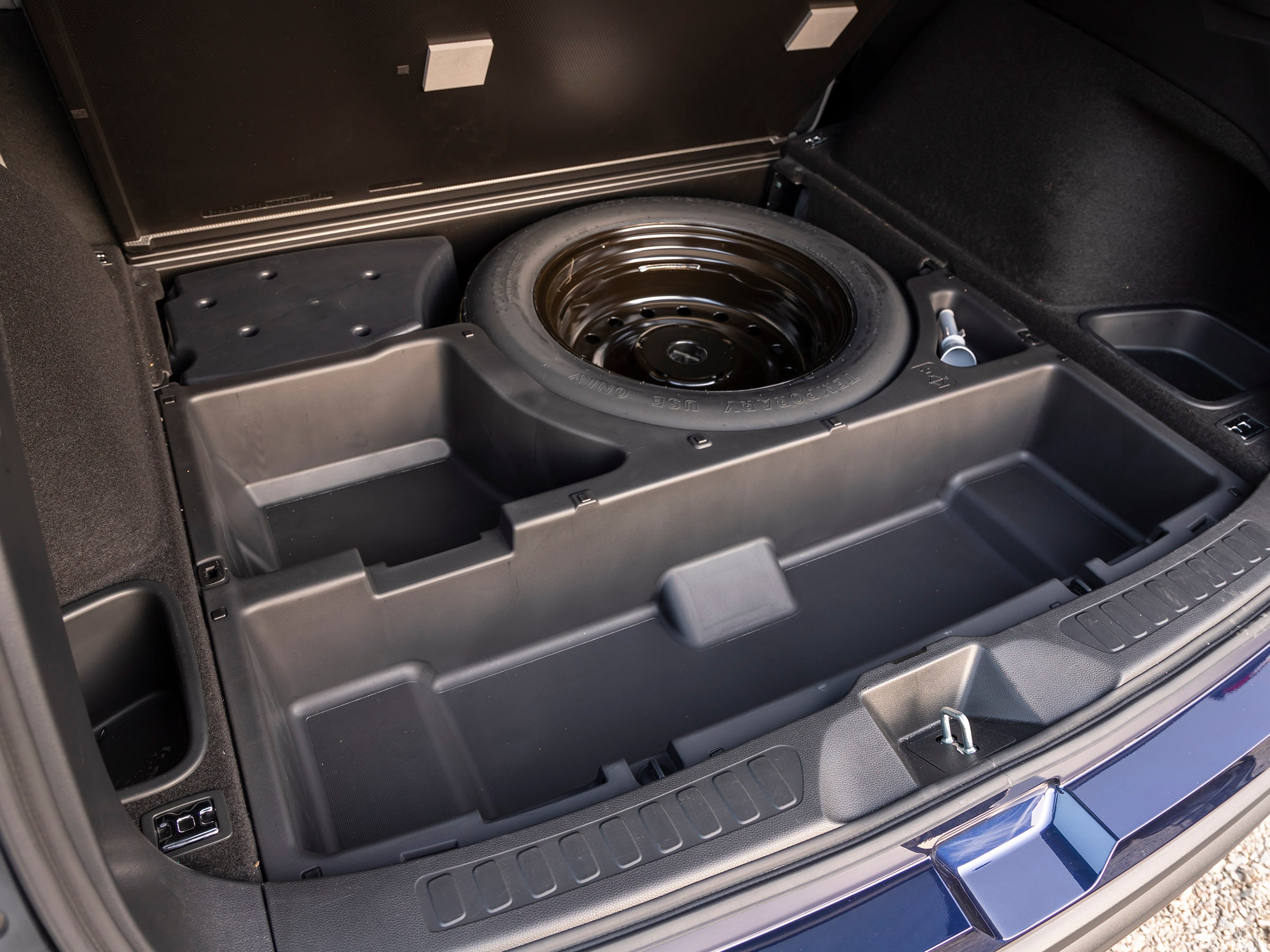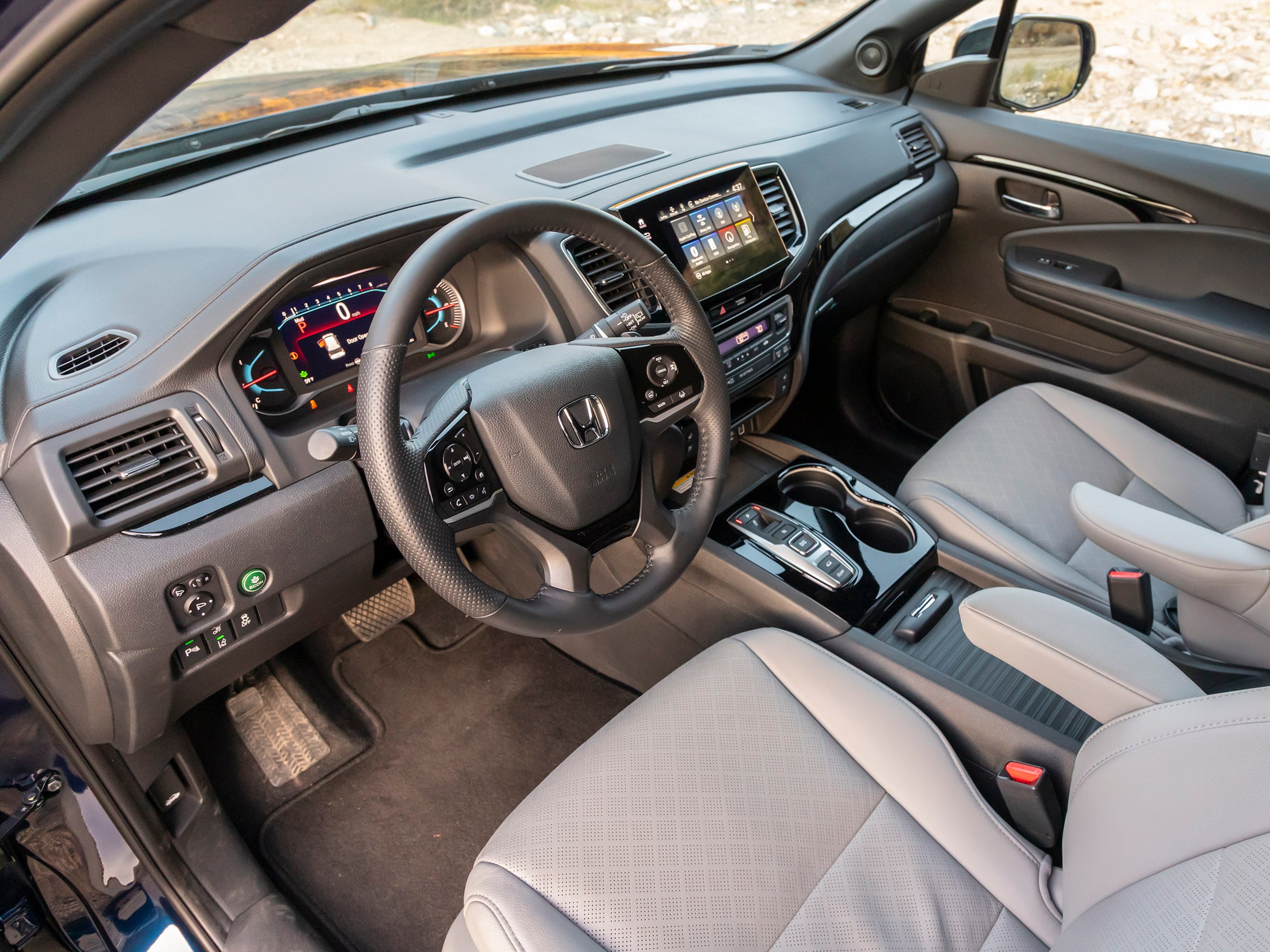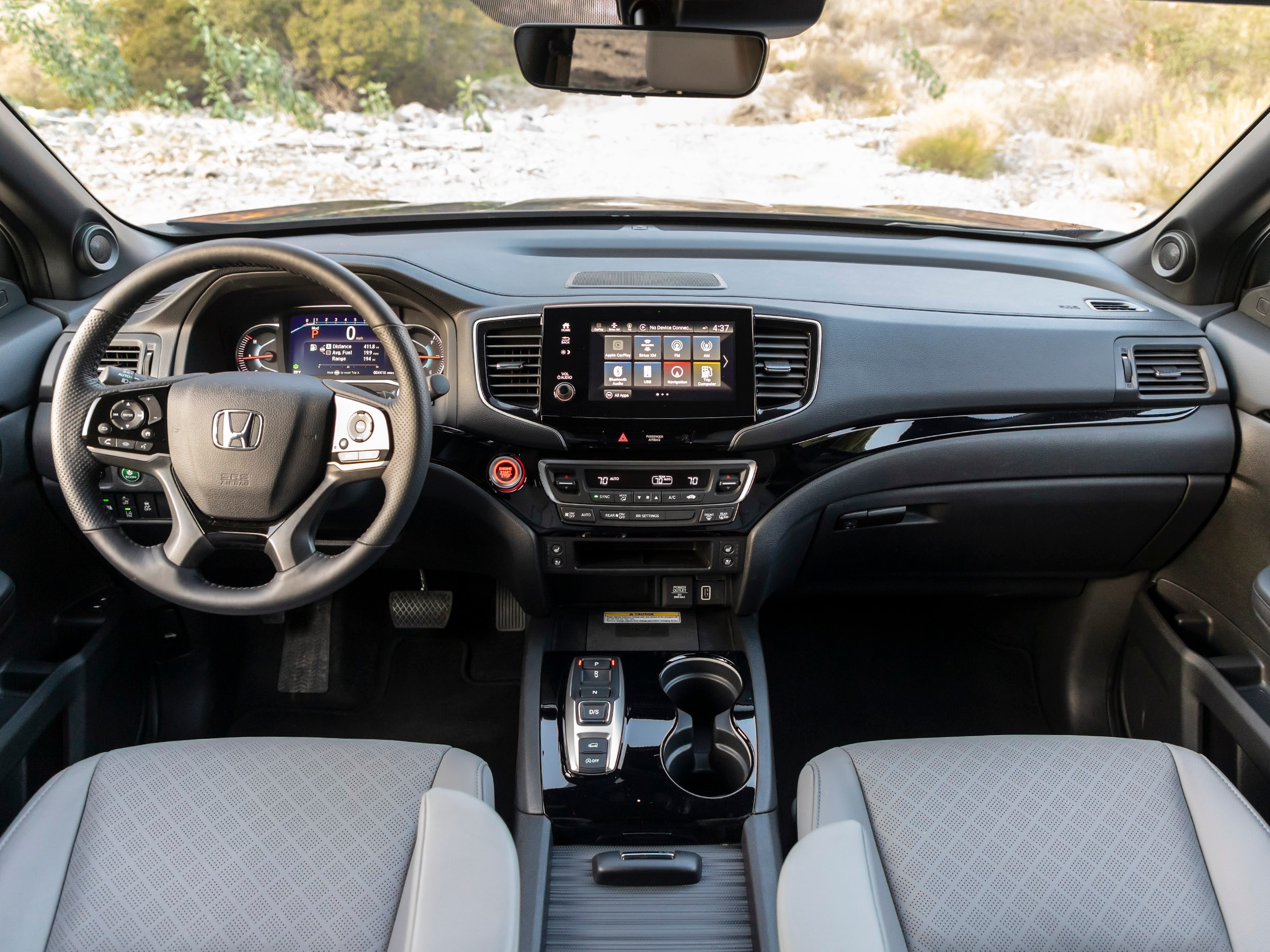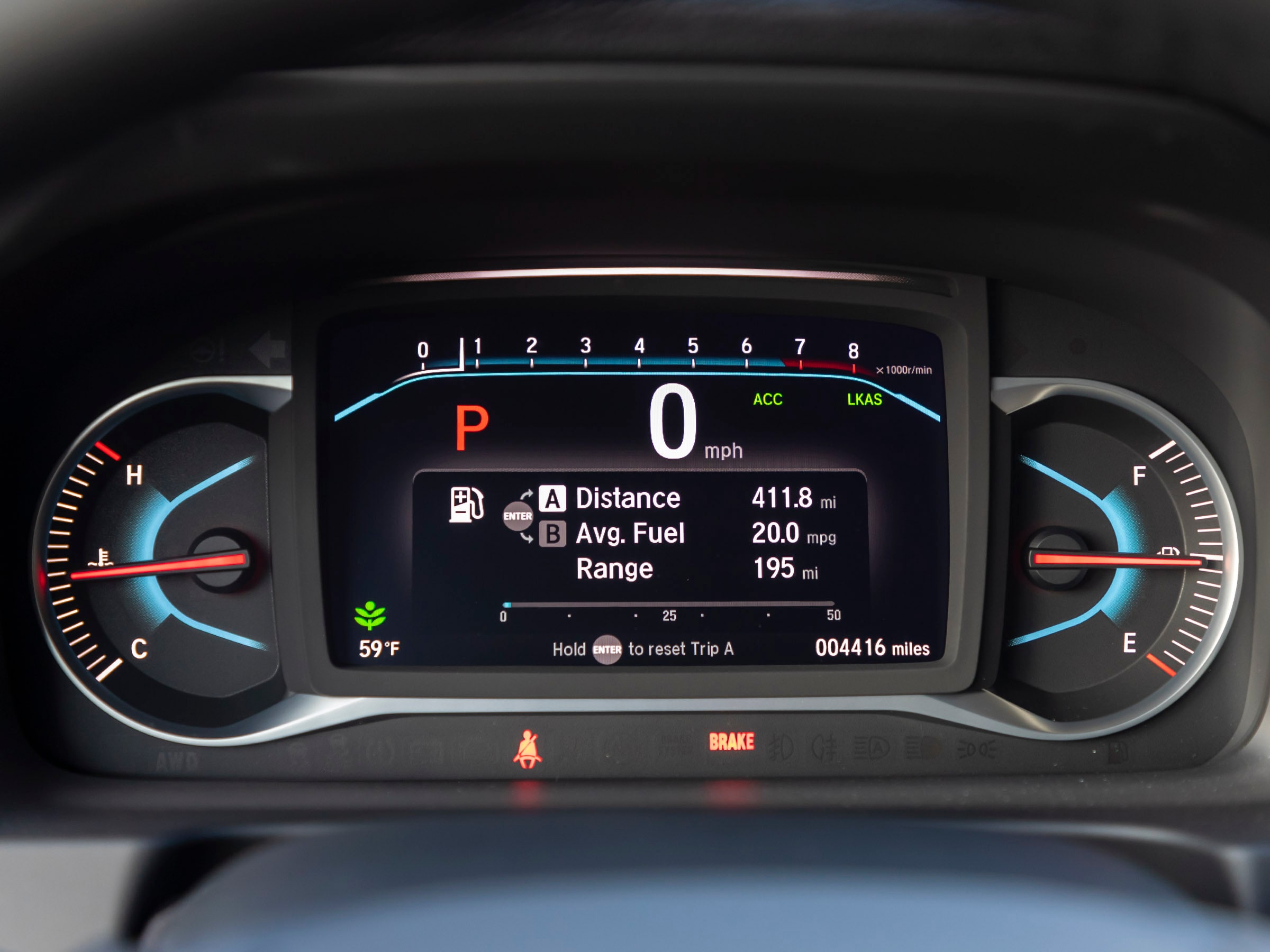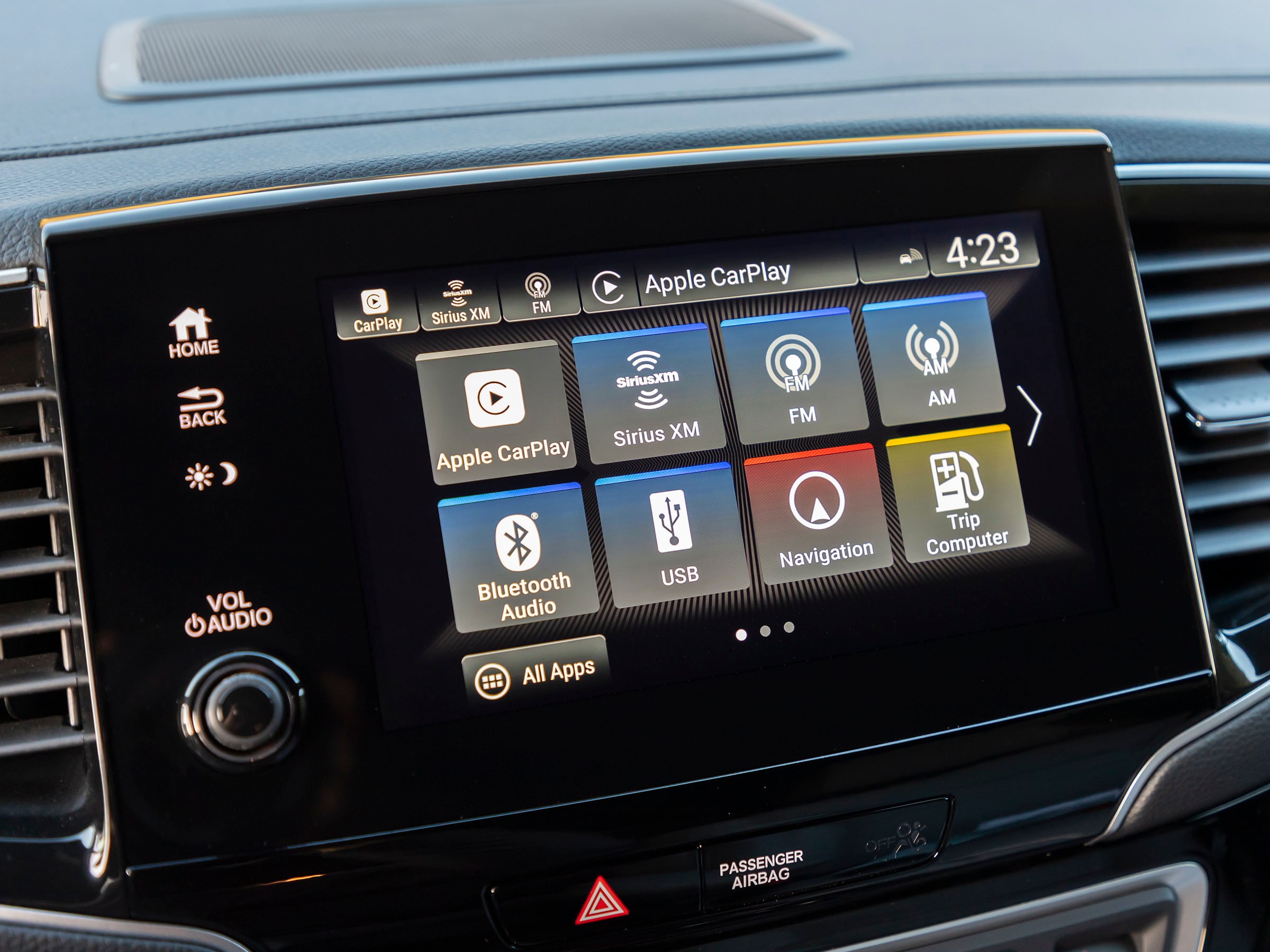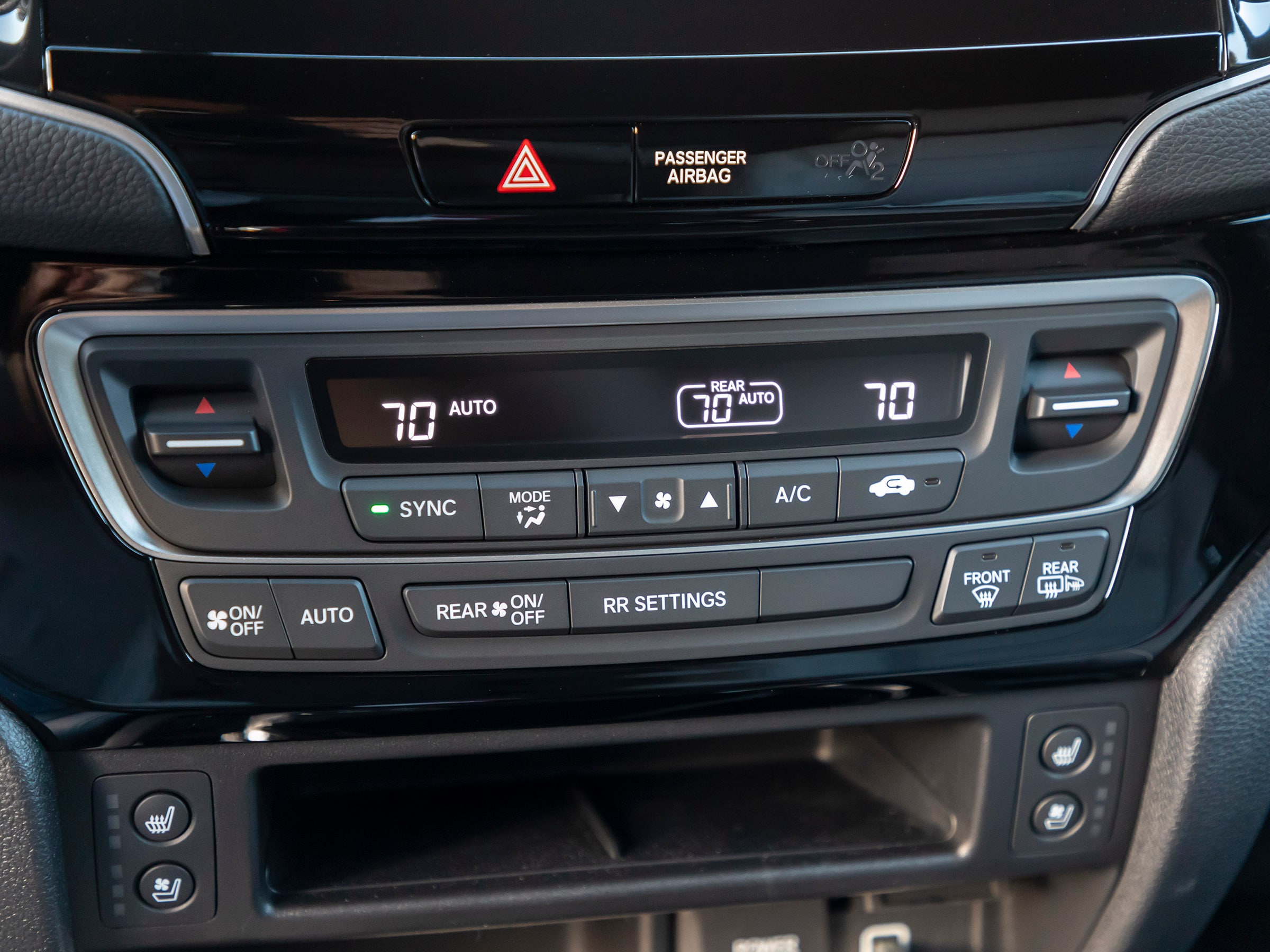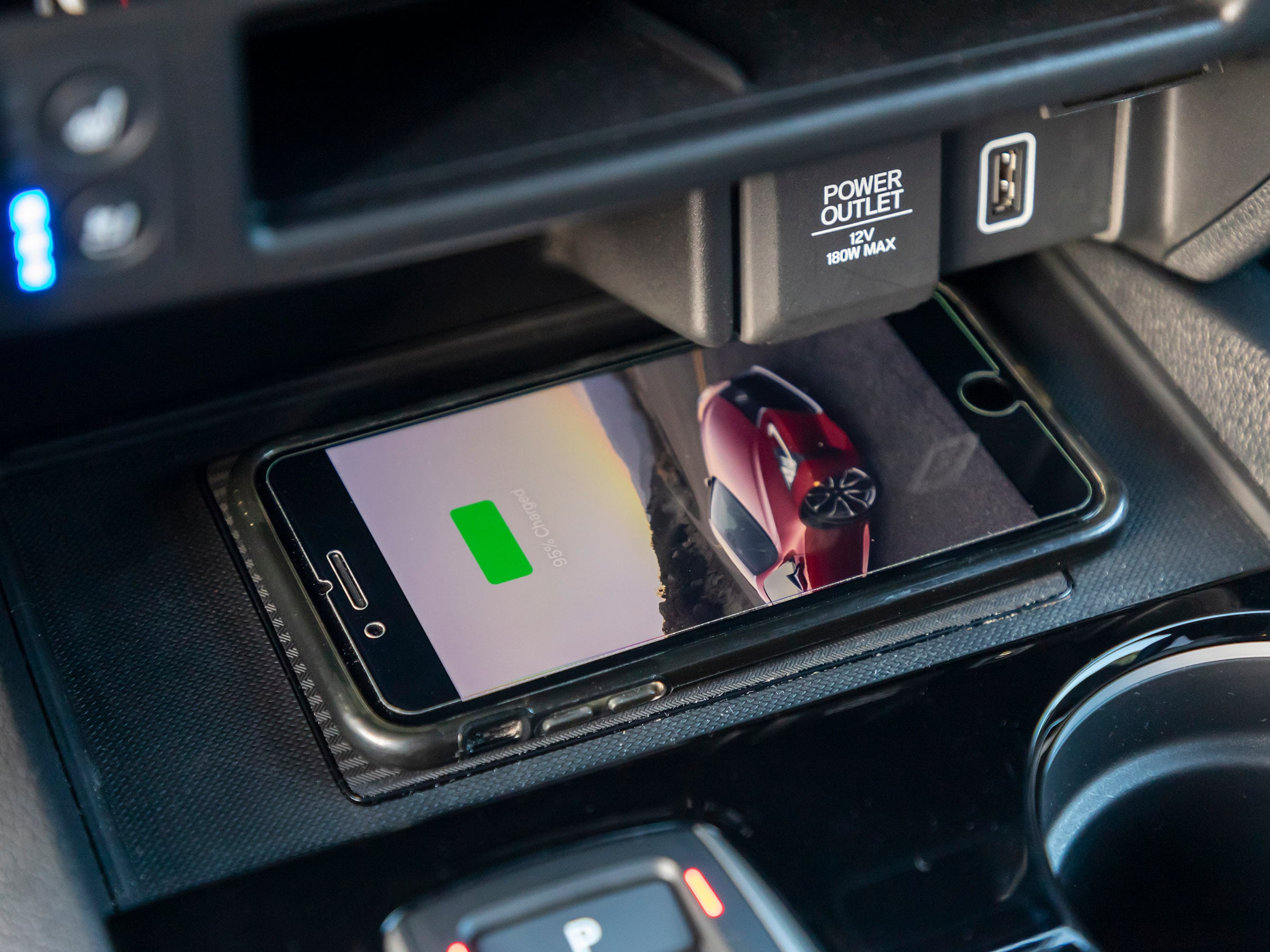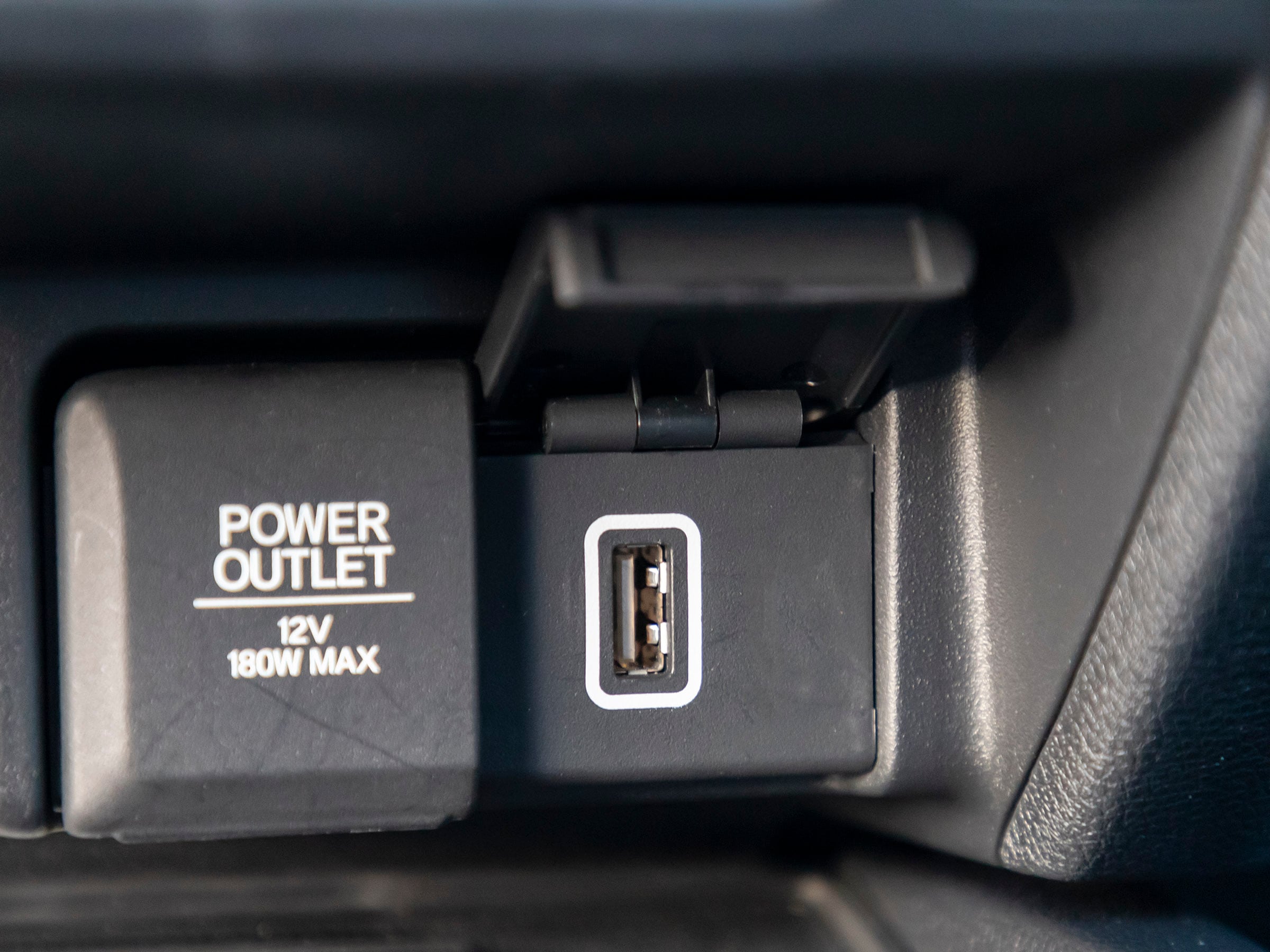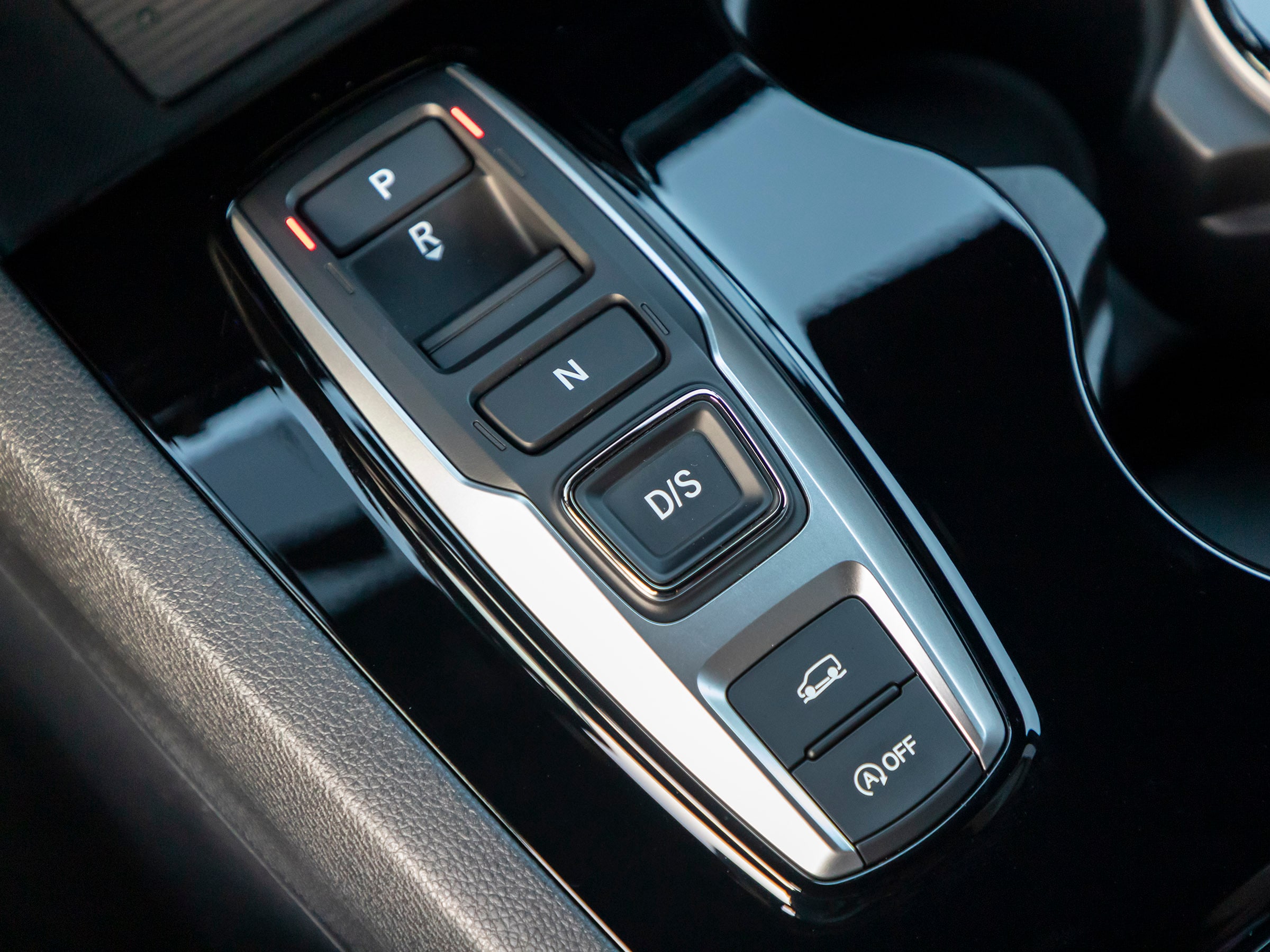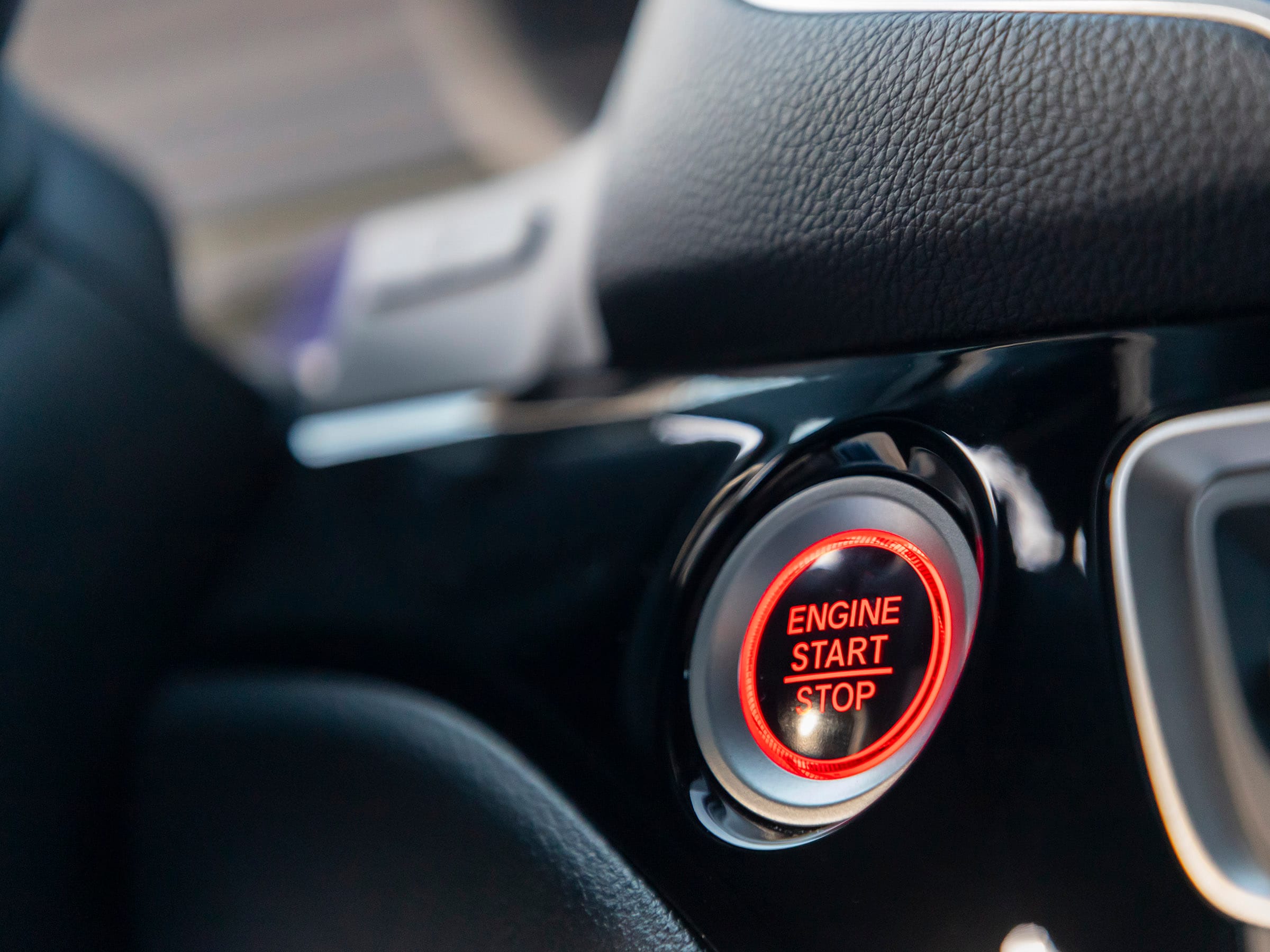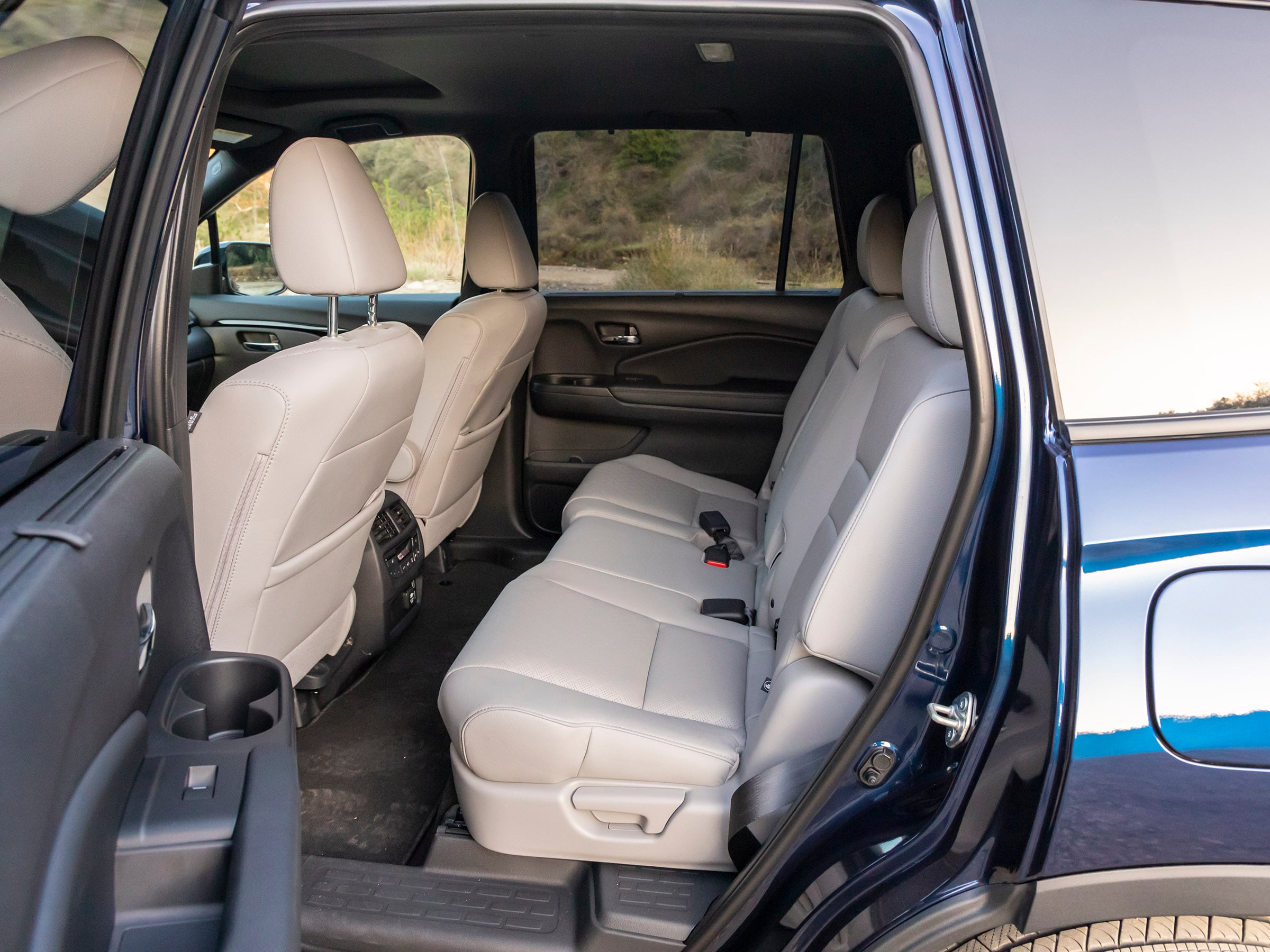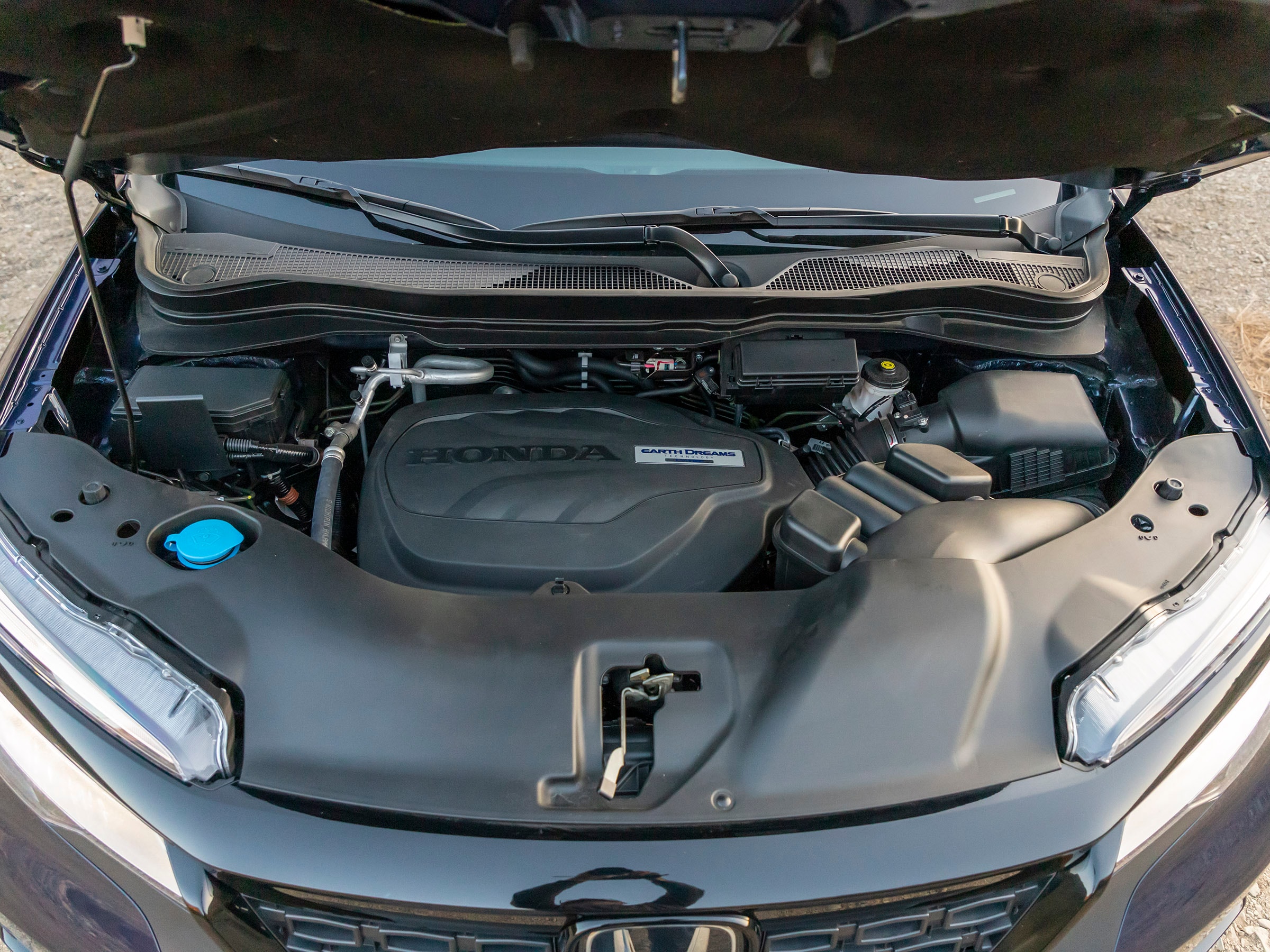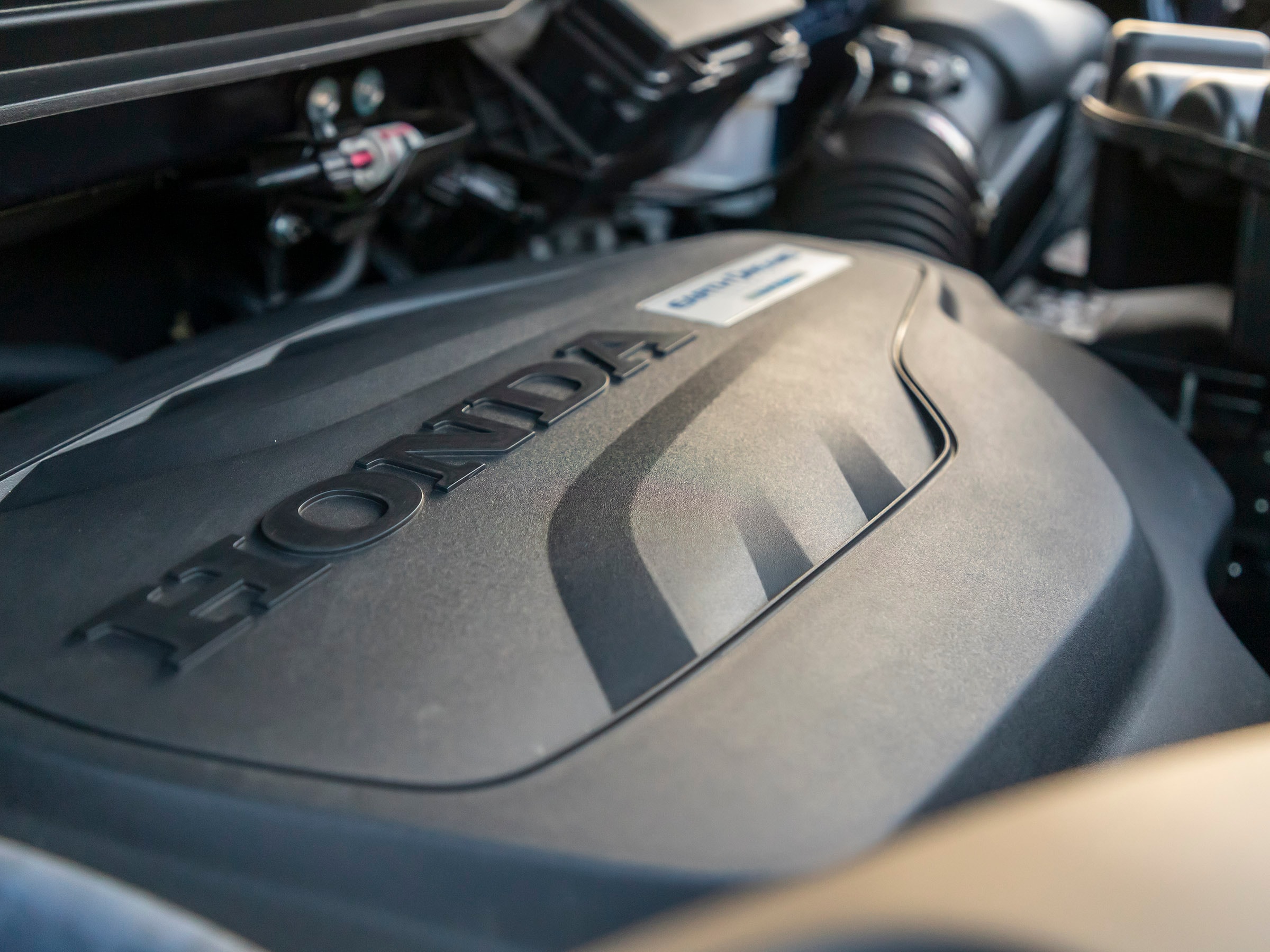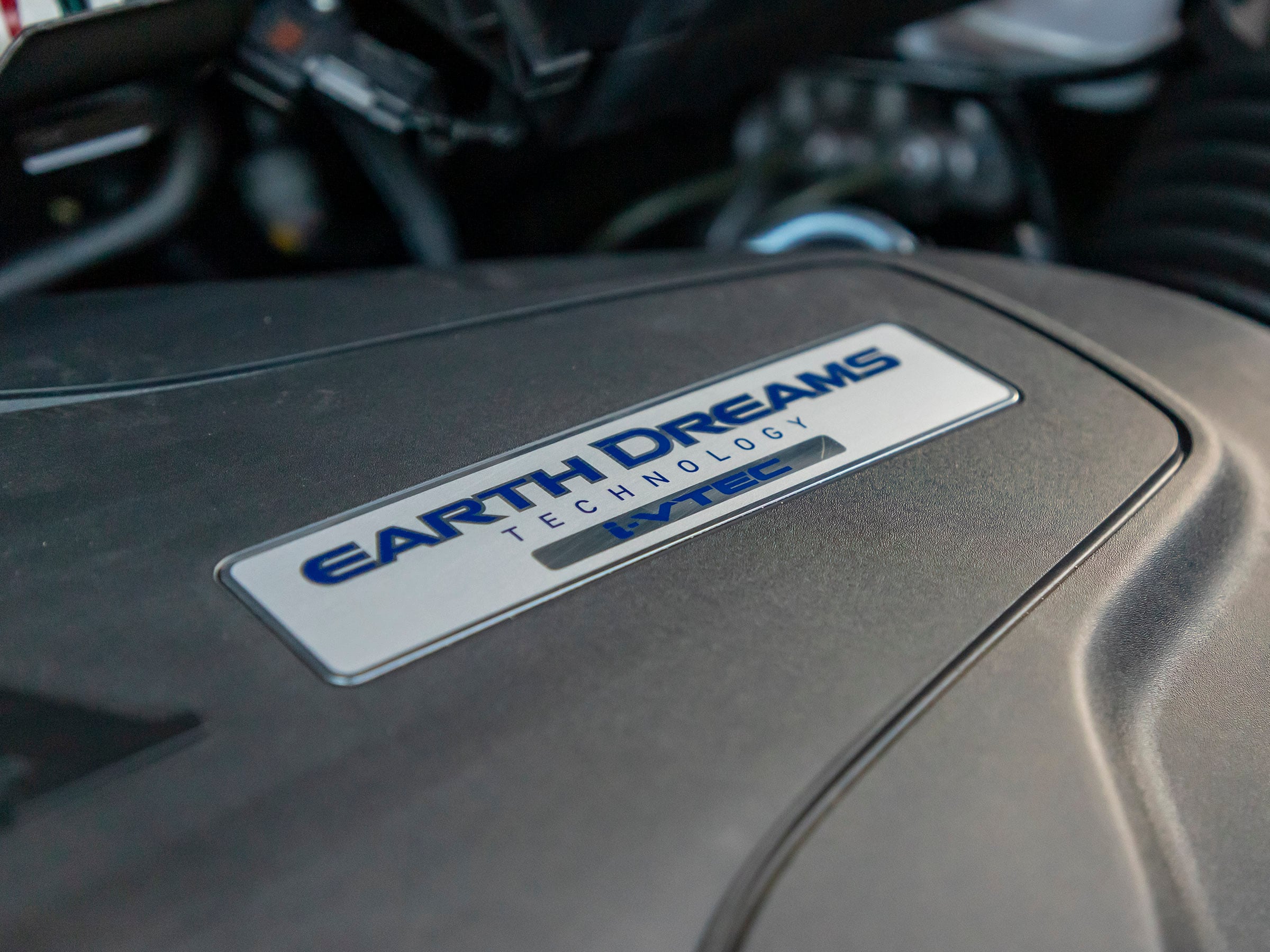We’re spending 12 months with this Honda Passport, reviewing the full ownership experience with ongoing updates.
The Passport’s mysterious little funnel
by Andy Bornhop on October 15, 2020
Price: $44,725 | Price yours
Current Odometer: 19,903 miles
Latest MPG: 22.5 mpg
Lifetime MPG: 22.6 mpg
Maintenance/Service Costs: $473.50
Days out of Service: 0
Whenever you lift the cargo floor of the Honda Passport to examine the spare tire and jack, there’s a good chance you’ll notice what looks like a small gray plastic funnel clipped into its own little sub-floor cubby.
What, exactly, is it? Well, upon closer examination, it indeed is a little plastic funnel. But why does Honda sell the Passport SUV with a funnel?
For oil? Nope. Our Passport hasn’t burned a drop in 20,000 miles.
Let us explain. The Honda Passport doesn’t have a fuel cap. At the gas station, you simply insert the fuel pump’s nozzle into the Passport’s fuel-filler neck and begin pumping.
For this to work properly and be safe, the Passport’s filler neck is fitted with two spring-loaded flapper valves that are pushed open when the fuel nozzle is inserted and snap shut for a proper seal when it’s removed.
If you ever run the Passport out of gasoline and need to refuel it with a portable plastic can (and no funnel), there’s a good chance you’re going to spill some fuel. Most people will get the top flapper valve open but forget that there’s a lower one as well.
Honda’s OE funnel helps prevent that smelly mess. When the plastic funnel is inserted in the fuel-filler neck, it holds both valves open without damaging them, thereby allowing fuel to flow freely into the Passport’s 19.5-gallon tank.
We’re pleased to report that nobody at KBB has had to use this handy little emergency refueling funnel, but we’re happy to have one at the ready. Thanks, Honda. A nice touch.
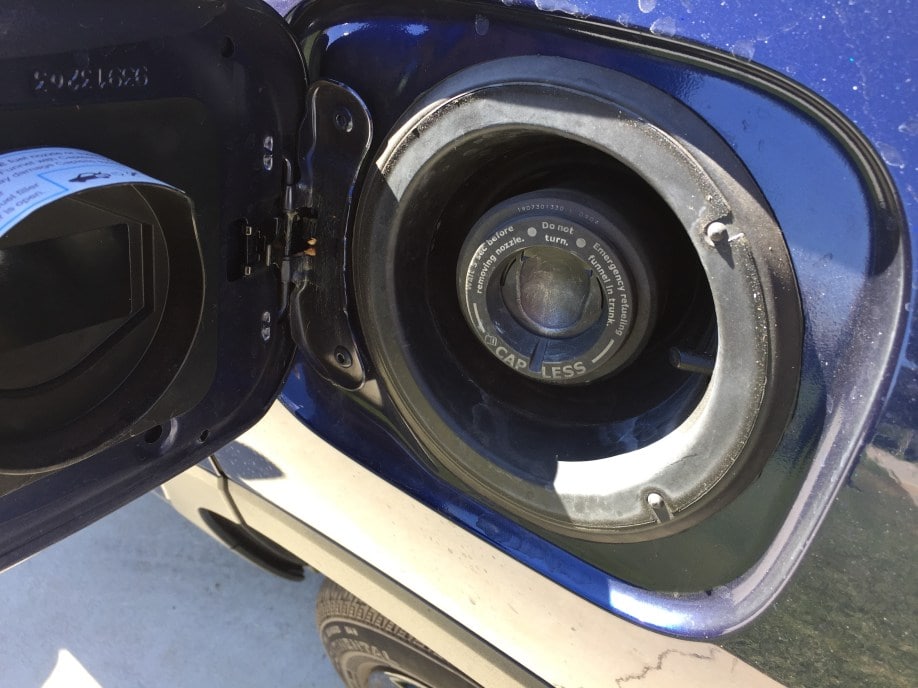
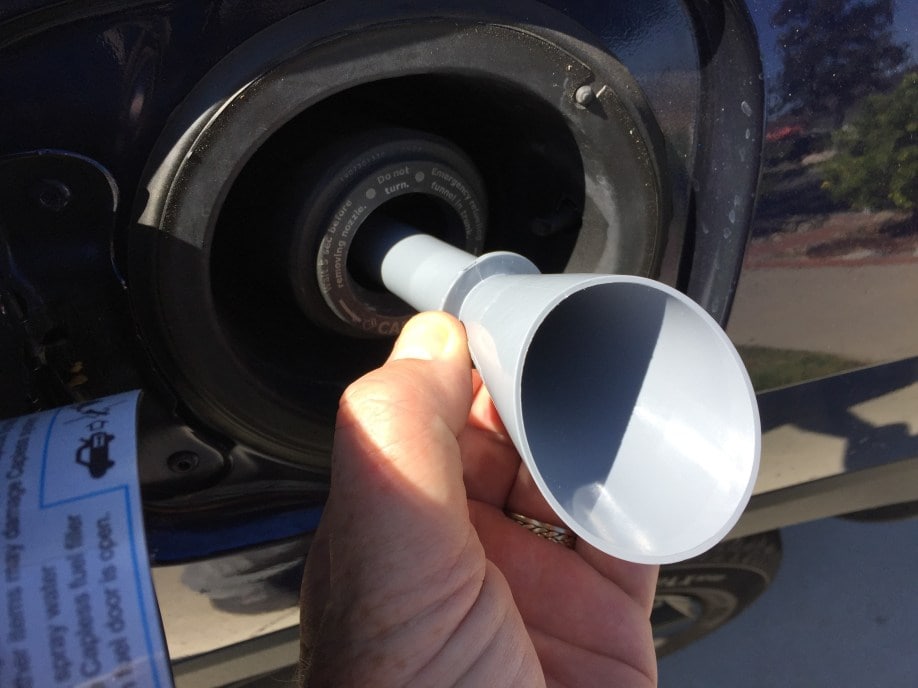
Our Honda Passport’s Bothersome Beeper
by Andy Bornhop on October 13, 2020
Price: $44,725 | Price yours
Current Odometer: 19,849 miles
Latest MPG: 25.8 mpg
Lifetime MPG: 22.6 mpg
Maintenance/Service Costs: $473.50
Days out of Service: 0
When you live with a vehicle long enough, you start noticing minor annoyances.
One such issue with KBB’s long-term Honda Passport is this – an overly loud electronic beep that’s emitted every time the power rear hatch is open or closed.
Whether you open the hatch via the button on the key fob or by grabbing the handle on the lower part of the hatch, the Passport makes the same loud annoying beep.
What’s it for? Do we really need a warning to tell us the power hatch is in action? Sometimes, all you want to do is sneak off for some early morning fishing without waking up the whole campground.
On our recent tour of the Southwest, we left the Kaibab Lodge early one day to catch the sunrise at the North Rim of the Grand Canyon. Naturally, we had to put our gear back into the Passport, so all chances of a quiet exit were ruined.
Grand scheme of things, not that big of a deal. Really. But there should be a way to shut this beeper off. We searched the Passport’s owner’s manual for a way to do it, but no luck.
As we approach the end of our year-long engagement with the Passport, its odometer will soon eclipse the 20,000-mile mark, underscoring just how popular this rugged 2-row 5-seat Honda SUV has been with the KBB staff.
A Utah Adventure in the Passport
by Andy Bornhop on September 25, 2020
Price: $44,725 | Price yours
Current Odometer: 19,680 miles
Latest MPG: 25.8 mpg
Lifetime MPG: 22.6 mpg
Maintenance/Service Costs: $473.50
Days out of Service: 0
With this working from home COVID thing lasting longer than expected, you can’t forget to take a vacation. So that’s what Patty and I did, taking KBB’s long-term Honda Passport on a 5-day Southwest Odyssey (to use the name of another popular Honda).
We left home on a Monday morning and came back, some 1,450 miles later, at about 10 p.m on Friday night. In between, we saw burned Joshua Trees (caused by a lightning strike) in the Mojave National Preserve; we e-biked up (and down) the spectacular Virgin River Gorge in Zion National Park; we visited Kanab, Utah (home of the Little Hollywood Museum & Trading Post); we soaked up the beauty at the North Rim of the Grand Canyon (replete with smoke from the Southern California wildfires); and we even cooled our heels in the chilly Colorado as it flowed through the Glen Canyon National Recreation Area. Our final night was spent at the quaint mid-century Red Rock Motel in Page, Arizona, before making the long drive back to SoCal through miles of Navajo land and the college town of Flagstaff, Arizona.
Not surprisingly, the Passport delivered. It reminded us that it’s a supremely capable and comfortable long-distance machine with plenty of space for our gear, which included a couple of folding chairs, two coolers, and a case of water. Although we didn’t do any off-roading, the full-time AWD of the Passport was appreciated when we tried, at one point, to circumnavigate the Kolob Reservoir on a dirt road.
Patty, at 5-foot-4, and I, at 6-foot-4, both found the Passport front seats to be all-day comfortable. That’s impressive. We also appreciated the seat coolers, even though their fans are a bit louder than we’d like. We never did need to use the seat heaters because the weather was so warm, but that gave the Passport’s automatic climate control a chance to show us its worth. Which it did, without problem.
The view out the Passport is excellent, which is important when you’re driving next to the Vermillion Cliffs for what seemed like 50 miles. The powertrain, featuring a 3.5-liter V6 and a 9-speed transmission, never skipped a beat, loafing along quietly below 2,000 rpm at highway speeds. We routinely shut off the automatic start/stop system, and liked how the shift paddles could be used on downhills for downshifts that would make life a little easier on the Passport’s 4-wheel disc brakes.
On such a long trip, you begin to appreciate the little things. The Passport’s capless fuel-filler for instance. While I used to think a capless fuel tank was the epitome of lazy, you get used to it pretty quickly and begin appreciating it at every fill-up. What’s more, we found the Passport to have a tremendous amount of storage in its front door panels and the cavernous center console, which has a sliding cover and served as an especially handy catch-all.
What did we keep in there? Just about everything, it seems. Our COVID masks. Our refueling log. A pen. All fuel receipts. My Nikon binoculars. Several recharging cables. A portable Bluetooth speaker. Add to that brochures and maps for three National Parks, plus my old iPod (which we couldn’t get to work in the Passport).
To while away the long miles across the desert, we plugged our iPhone into the forward USB port and tuned in to several podcasts using Apple CarPlay, most frequently one called “In the Dark” that we found riveting. We’re happy to report that we never experienced any of the crackling static and popping sounds we’ve heard previously from the front speakers.
On our tour of the Southwest, with 33 psi in all four tires and many a long highway stint, the Passport averaged nearly 26 mpg. This has helped bump its lifetime fuel economy to 22.6 mpg, very much in line with this roomy 5-seat Honda’s official EPA fuel-economy ratings of 19 mpg city/24 mpg highway.
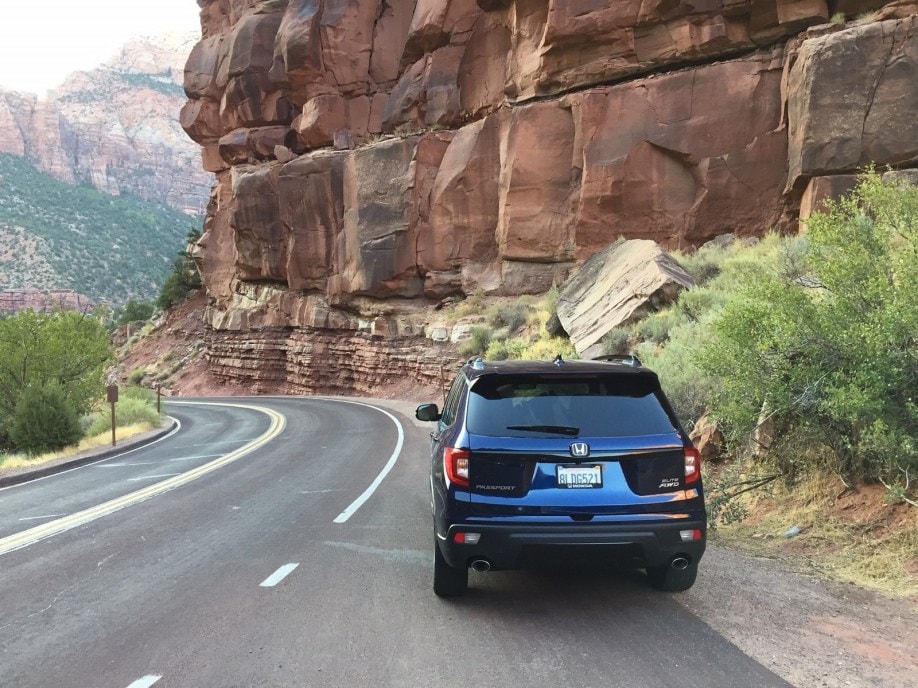
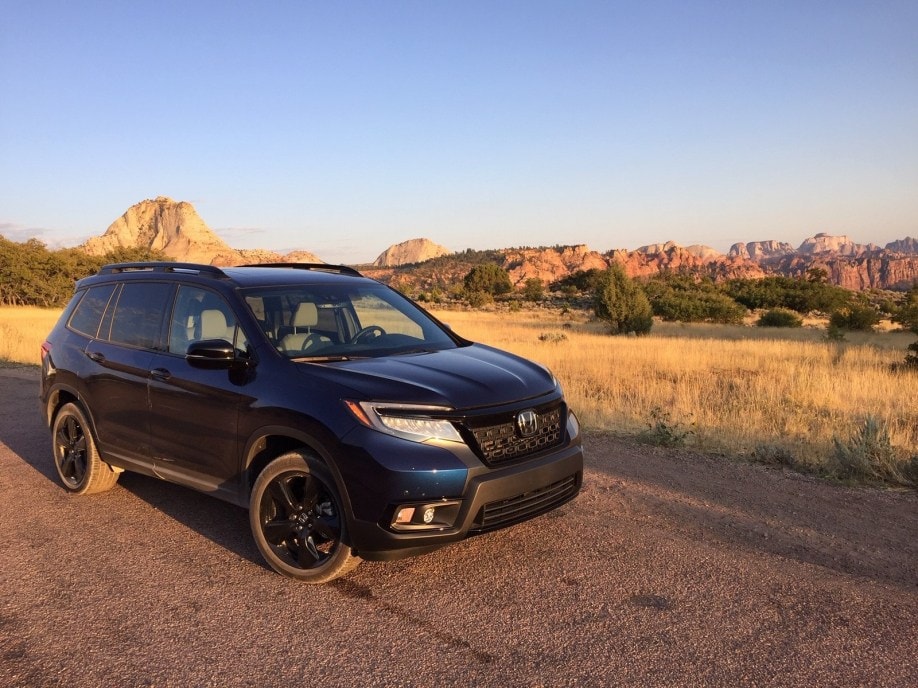

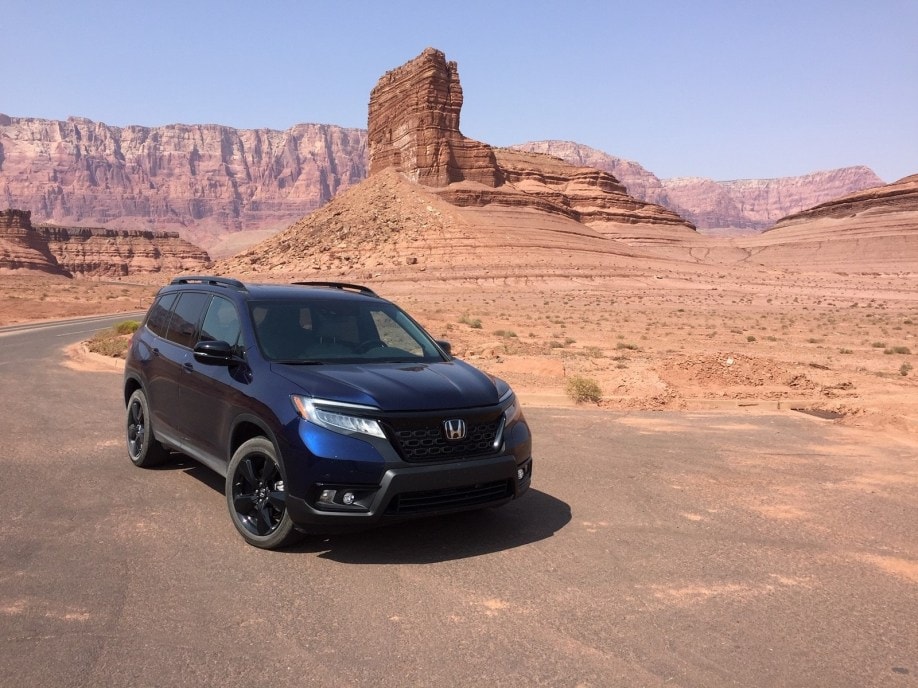
Service Time
Price: $44,725 | Price yours
Current Odometer: 17,257 miles
Latest MPG: 24.3 mpg
Lifetime MPG: 21.1 mpg
Maintenance/Service Costs: $205.00
Days out of Service: 0
After our road trip to Chicago and back, we were a bit past due for our 15,000-mile service interval on our 2019 Honda Passport, so it was off to Norm Reeves Honda in Irvine. Making the appointment online was a piece of cake, we were greeted on time. I was able to hang around at the dealership with my laptop in the socially distanced waiting room.
Normal 15,000-mile service includes an oil change, oil filter replacement, and topping off fluids. Also as part of the service is a multi-point inspection that didn’t turn up any issues. However, there was also a service code on the dash that indicated the rear differential oil needed to be changed. Normally this is done every 30,000 miles, but the service advisor recommended it be changed after the normal vehicle break-in period, so now we are good for another 30,000 miles. That extra bit of maintenance added $121 to our bill, $80 for the labor, and the balance for the flush and replacement fluid.
The oil change itself included $30 for the oil and filter plus $50 for labor. In all the total came to $205 including tax. It took a little over two hours for the service. The only gripe is that for all that work, a free carwash wasn’t included.
A Long, Not-so Strange Trip
by Matt DeLorenzo on July 29, 2020
Price: $44,725 | Price yours
Current Odometer: 17,073 miles
Latest MPG: 24.3 mpg
Lifetime MPG: 21.1 mpg
Maintenance/Service Costs: $0
Days out of Service: 0
After 4,310 miles in the saddle, I can safely say that the Honda Passport is a great road tripper. The V6 engine and 9-speed transmission provided plenty of cruising power and pretty good fuel economy averaging between 23 and 25 mpg for the most part and hitting 26.5 mpg on one stint that included some high speed coasting down the backside of the Rocky Mountains on the return trip home.
A couple of things we were able to appreciate over time (since I had rear-seat passengers on the return trip from Chicago) was the rear AC vents and the great legroom. Also, while the Passport doesn’t have the third row offered by the longer Pilot, it has a similar width, so there’s plenty of elbow room for both front and rear passengers.
Other likes included the generous cupholder and large center console bin which swallowed up multiple water bottles and large fast-food cups, the intelligent cruise control which functioned flawlessly, and the large outside mirrors with blind-spot warning, all good to have when cruising cross country.
As for the trip being long and not so strange, to borrow loosely from the Grateful Dead, life on the road was pretty normal. Hotels are taking measures to put plastic dividers in the front desk area, a lot of restaurants offer outdoor seating and other than a few places, like New Mexico where it was difficult to find a bathroom, it was pretty much business as normal.
We did stop in Las Vegas and it’s interesting how the town has adapted to social distancing and mask-wearing. Of course, helping a lot was a lack of people-crowds were probably about a third of what you’d usually see there. That also contributed to the smoking deals on hotel rooms–a downtown room at a major casino was about $50.
Overall, with gas prices down and affordable hotels available on the road, traveling by car is a pretty good deal, especially if you’re concerned about being seated in close proximity to strangers for several hours on an airplane. Over the 4,000-plus miles, we put 188 gallons of fuel in the Passport, spending $473.50, plus $5 for a gallon of window washer fluid in Nebraska. (Sadly, we took out a lot of butterflies along I-80). We saw per gallon prices of fuel range from as high as $3.36 in my hometown of Lake Forest, Calif., to $1.88 in Pacific, Mo. All in all, it was a fun trip and a relatively easy driving experience thanks to the Passport. We did run the odometer up past the 15,000 mark, so it’s on its way for regular servicing and back in the fleet for more daily driving duty.
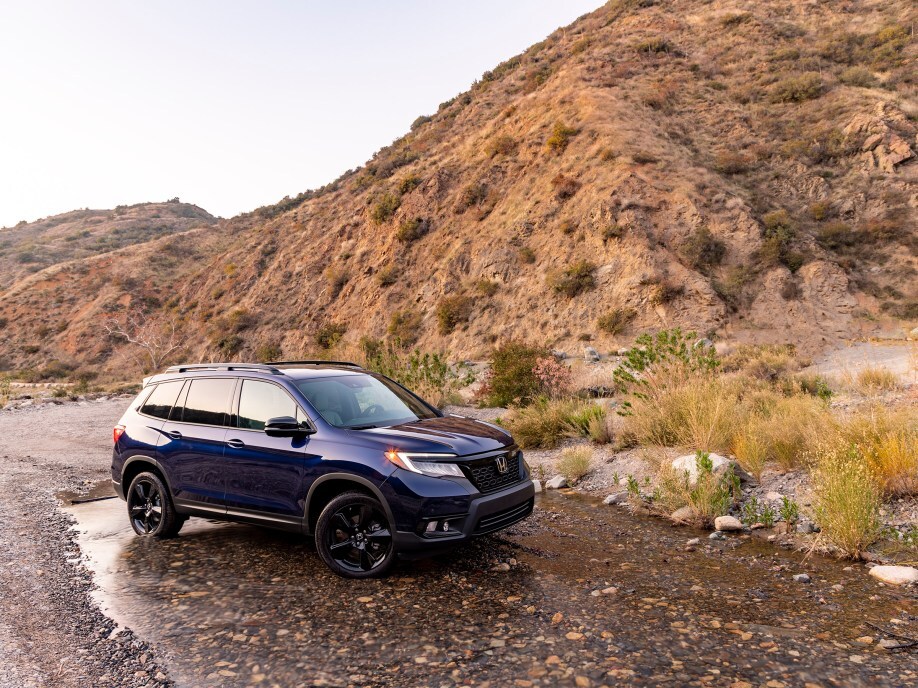
On the Road Again
by Matt DeLorenzo on July 20, 2020
Price: $44,725 | Price yours
Current Odometer: 14,973 miles
Latest MPG: 24.2 mpg
Lifetime MPG: 20.6 mpg
Maintenance/Service Costs: $0
Days out of Service: 0
It’s been way too long since our last update. The Honda Passport is being passed around the staff to get different opinions. For my turn, I decided on a long road trip to Chicago and back. Currently, I’m halfway through the trip and the Passport has been an agreeable partner on this long trek.
As Sean indicated in his shorter trip, the strong suit of the Passport is its ride and handling. The larger footprint of this 2-row SUV versus our long term RAV4 pays off in a more settled feel on the road. The width of the vehicle also translates to a comfortable layout, although I wish the seats had a bit more support, especially after a long day in the saddle.
Honda’s attention to isolating the cabin is most appreciated. The relative quiet and solid feel of the body structure do their part to help melt away the miles. There are also plenty of cupholders and storage cubbies to keep the usual road trip detritus (snacks, phones, recharging cords, etc.) fairly well organized.
Over the 2,065 miles traveled from Orange County to the Windy City, we averaged 23.6 mpg. Our per tank range was comfortably over 400 miles and we often would put 17 to 18 gallons in the tank. I appreciate the capless filler, a nice convenience.
Mechanically, the Passport has plenty of punch from its V6 engine to keep up with traffic. The 9-speed transmission is fairly seamless, we only felt the odd clunk that others have complained about only once. Also, we didn’t encounter the random crackling noise from the sound system…everything seemed to work just fine on our long haul. I will say though that I’d appreciate more standard controls beyond the sound system volume knob. I find touchscreen controls a distraction when fiddling with various systems on the fly.
So far, so good. We’ll see how the Passport fares on our return trip home.
Our Rolling Survival Cell
by Andy Bornhop on July 12, 2020
Price: $44,725 | Price yours
Current Odometer: 12,544 miles
Latest MPG: 22.7 mpg
Lifetime MPG: 21.0 mpg
Maintenance/Service Costs: $0
Days out of Service: 0
We took our Honda Passport on another weekend adventure, this time to explore the area around the Salton Sea in the far southern part of California. The sea – basically a huge saltwater lake created by accident in 1905 – is about 150 miles from home, and it sits right atop the notorious San Andreas Fault. But it’s a pretty drive that took us through the mountain town of Julian (where we stopped for an iced coffee) and then across the beautiful California desert.
And, yes, as you might expect, it was excruciatingly hot out there. At one pullout, when we hopped out of the Passport for our first view of the Salton Sea, it felt like we had just stepped into a sauna. Without the moisture. None of us had ever felt oppressive outdoor heat like that before.
Just how hot? Try 118 degrees Fahrenheit, as indicated by the Passport’s exterior thermometer. But we’re happy to report that the Passport’s climate control system had no trouble keeping the 5-seat interior at a constant 68 for our whole trip. Immediately, we began thinking of the Passport as our rolling survival cell.
And it proved to be a great vehicle for this trip. It cruised comfortably at 65 mph on the highway. It provided plenty of room for the three of us. We enjoyed the Prime Country, Tom Petty and First Wave stations of its XM satellite radio. And we appreciated the Passport’s all-wheel drive and extra ride height (as compared to the longer 3-row Pilot) on the dirt roads of the rural communities and neighborhoods surrounding the Salton Sea, which is below sea level and unfortunately suffers from a foul smell related to algae blooms and resultant fish die-offs.
One oddity: At one point, while headed south on 111 to visit the Bombay Beach community on the east shore, it sounded like tiny bits of gravel were hitting the Passport’s windshield. But such was not the case. Rather, it turned out that the Passport’s stereo system was emitting a random crackling sound from the tweeter speakers mounted in the A-pillars. We’ll have this issue—which happens with stereo on or off—investigated at the Passport’s next service, but it will be tough to replicate for the dealer.
(Note: A quick search on the web indicates that this crackling sound is a known issue with the Passport, one that’s apparently fixed by an updated dash harness.)
After checking out the eclectic community of Bombay Beach, and later the equally bizarre Slab City and Salvation Mountain, we headed back home on Interstate 8, taking advantage of the Passport’s effective adaptive cruise control for much of the way.
Fuel economy for our 400-mile adventure: a respectable 23 mpg.
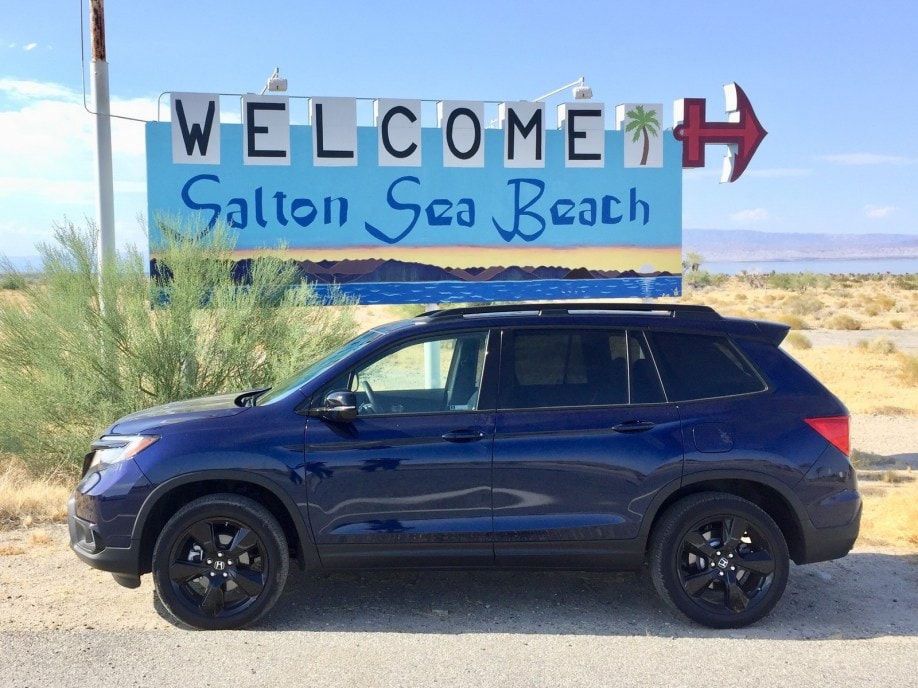
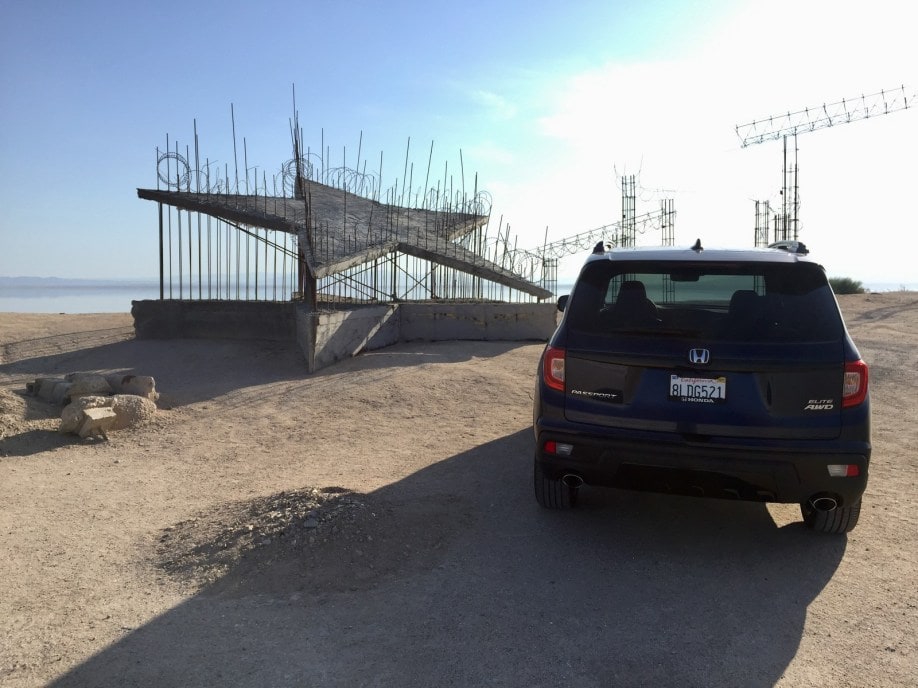

Road Trip King
by Sean Kealey on April 15, 2020
Price: $44,725 | Price yours
Current Odometer: 8,692 miles
Latest MPG: 20.2 mpg
Lifetime MPG: 20.6 mpg
Maintenance/Service Costs: $0
Days out of Service: 0
If Honda built a practical, spacious SUV named after a document that takes you places, well, I might as well use it for its namesake. So, a spontaneous road trip to Las Vegas was planned. (This road trip occurred before the city-wide shut-down mandate was in place due to Covid-19).
Road Warriors
We packed the Passport with bags and coolers enough for three passengers. While the load floor is rather high in the trunk, plenty of space accommodates luggage for five people. The large hidden storage compartment just aft of the spare tire compartment fits an air compressor and first aid kit. We also stored a tire pressure gauge, a quick detailing kit, a blanket, and a camera bag in it. This spot proves useful for any bags you don’t want potentially crushed or that may spill. It’s plastic lined. The absence of road noise and very little wind noise inside the cabin made for a peaceful drive. Add the soft suspension soaking up the highway miles and it seemed borderline luxurious. One buddy slept for two hours of the journey and woke up actually refreshed.
While the fuel economy may not be the greatest, the car does come with a 20-gallon fuel tank, so it offers plenty of range. Thankfully the Passport runs on 86-octane gas, so you won’t have to splurge for premium. I was seeing roughly 400-500 miles out of a tank of gas on the long highway drives.
If I had one gripe regarding the Passport it would be the sound system. It’s not bad, but other Honda vehicles with lower price points have better-sounding systems. A better sound system would add to the cabin’s insulated feel. It generates decent clarity and depth but could use more power and volume.
Great Handling Chops
Honda touts the Passport as their most off-road capable vehicle in the lineup. Does this mean that it has abandoned all its on-road manners? This could not be further from the truth. The Passport rides and handles great on highway and city streets. Potholes are dispatched with ease given the compliant suspension and large profile sidewall tires. Body roll makes itself known in corners. However, given the compliant suspension, the way this car manages to sort itself out and get around a turn feels remarkable. Honda engineers have struck a fine balance between off-road capability and on-road drivability.
Count its steering as another aspect that makes the Honda Passport such a great driving SUV. Some manufactures tend to make the steering too light in the name of ease and comfort. The Passport has perfectly weighted steering to suit the character of the vehicle. It feels relatively light but just heavy enough that the steering wheel does not dance around on the highway. That stability brings confidence when driving on the interstate. The seating position and massive greenhouse afford the driver fantastic outward visibility. For such a large SUV, it proves an easy car to navigate through a parking lot.
For an SUV, the Honda Passport has enough off-road performance to be considered sporty and more than enough utility to excel in its segment.
Engine Notes
by Sean Kealey on March 30, 2020
Price: $44,725 | Price yours
Current Odometer: 6,649 miles
Latest MPG: 21.9 mpg
Lifetime MPG: 20.7 mpg
Maintenance/Service Costs: $0
Days out of Service: 0
What is there to say about an SUV that does just about everything well, but nothing great? Is it really a jack-of-all-trades and a master of none? There is more to the 2019 Honda Passport than that. Let’s talk about the powertrain.
2019 Honda Passport Engine Overview
The 2019 Honda Passport comes with Honda’s famous 3.5L V6 engine (internally known as the J35Y6). It is shared in several other Honda models and is part of the J series of Honda engines that have been in production since 1998. They are infamously reliable and will help the Passport hold it’s resale value on the used car market as the engine won’t be adversely affected by all of the miles you add on to this fantastic daily driver.
The motor delivers power smoothly and effortlessly. While no one is buying a Passport for the way it sounds, drivers will be happy to hear this engine roar to life under hard acceleration. This is largely the same engine that has been in the last few generations of Acura TL, including the Acura TL Type S. Seriously; this engine sound will put a smile on your face when you are on an empty highway on-ramp.
Transmission Frustrations
The Passport uses a 9-speed automatic transmission manufactured from ZF. This 9-speed is designed to be packaged with FWD or RWD cars. It is shared in a number of different vehicles across several different brands. For us, this transmission comes with some issues. It struggles with feeling consistent with shifts.
Why is that? Different gearshifts engage differently. The 4-5 and 7-8 gearshifts are actually dog clutch gear compared to a traditional clutch pack. This does not lead to the most refined driving experience.
The transmission tuning is geared more for fuel-efficiency. While this helps with fuel economy numbers, it mostly impacts the driving experience on the highway. The transmission will try to hold the car in a higher gear for as long as possible. This keeps the engine revving lower, thus saving fuel. The problem is, this gearbox matched with this engine does not feel like the best pairing.
The naturally aspirated nature of the V6’s power band lends itself to unusable low-end torque. With a transmission trying to keep the revs low, the SUV tends to feel lethargic unless you push the pedal to the floor. In “Eco Mode” the problem is only exacerbated. This isn’t to say that it’s a bad transmission; it’s just not well suited to the engine. Shifts are generally smooth and quick enough for an SUV.
Honda designed and built a new 10-speed transmission that currently lives in the Honda Accord. It is a wonderful transmission and we encourage Honda to put in more models.
A Tale of Two Honda Technologies
by Sean Kealey on February 21, 2020
Price: $44,725 | Price yours
Current Odometer: 5,396 miles
Latest MPG: 17.9 mpg
Lifetime MPG: 20.5 mpg
Maintenance/Service Costs: $0
Days out of Service: 0
The Honda Passport welcomes its occupants with an intuitively laid out, spacious cabin. Materials are durable but stylish, and the overall layout is simple without appearing too boring. While the interior offers a no-nonsense, pragmatic approach to design, how does the Passport’s technology stack up?
Infotainment switcheroo
The Passport features an eight-inch infotainment touch screen. Honda’s newest software is an Android-based software, rather than the frequently used Panasonic-based software used in many other car manufacturers. The system itself is snappy, quick to respond, and well laid out. The screen provides HD graphics with great contrast and colors.
The home screen is reconfigurable much like an iPhone or Android screen using a system of tiles for each sub-menu. The Garmin-based GPS system provides excellent map details and concise driving instructions.
My only major gripe with the infotainment system is with the hardware. Why? Because Honda offers a better version of it in one of their other cars. Let me explain. On the left side of the Passport’s touchscreen, there are three buttons and a volume knob: home, return, and brightness adjustment. That’s it. Everything else has to be done using the touch screen. Why is this a problem? Navigating between submenus generally requires a few extra steps that a hard button would have solved with one push.
Want to go from Apple CarPlay to satellite radio? Hit the home button, then go into the satellite radio screen, then use the touch screen to tune the station to anything you don’t have as a preset… see where I’m going with this?
The Honda Accord uses the exact same infotainment software. It has the same screen size but offers an additional five hard buttons for skipping forward and back from music or radio stations, a tuning knob, and more hard buttons for sub-menus. It is just about the perfect set up in my opinion. Not too many buttons, not too few buttons (I’m looking at you Honda Civic). It’s just right. Such a simple change by stealing the Accord’s set up would make for a much more enjoyable and less complicated UI experience.
Not all Honda Sensing systems are created equal
Honda has created a system of driver’s assistance safety features that it calls Honda Sensing. These features include a Collision Mitigation Braking System, Road Departure Mitigation System, Adaptive Cruise Control, Lane Keep Assist, and Traffic Sign Recognition. However, some of these features are slightly different depending on the model.
Once again, I will refer to the Accord. The adaptive cruise control function in that car features a stop-and-go function for when traffic is crawling along on the highway and occasionally stops and starts again. The Passport’s stop-and-go functionality automatically shuts off when the car begins to go below 20mph.
It seems strange that an SUV is devoid of the same features that a car in the same model year, which costs $8,000 less has. Beyond that, the features work well. The lane-keep assist steering on the highway makes road trips a breeze and very comfortable in conjunction with the adaptive cruise control.
A Passport to weekend adventures
by Andy Bornhop on February 7, 2020
Price: $44,725 | Price yours
Current Odometer: 4,877 miles
Latest MPG: 19.4 mpg
Lifetime MPG: 19.4 mpg
Maintenance/Service Costs: $0
Days out of Service: 0
The original Honda Passport was an elemental little motorcycle with an air-cooled 70-cc engine, a step-though frame, a covered drive chain and a well-padded seat for two. Google it; it’s a cool bike.
KBB’s long-term Passport is a totally different beast, but we feel this spacious 5-seat Honda SUV is properly named because it represents another sort of passport (sorry) to adventure. As an all-wheel-drive crossover SUV with short overhangs and an inch more ground clearance than the Pilot on which it’s based, the Passport will take you to far-off destinations in total comfort and then tackle dirt roads that might otherwise scare off those more city-centric crossover SUVs.
This is exactly what we did on a recent weekend when four of us piled into the Passport one chilly Saturday morning for a day of sightseeing and exploring in the greater Mojave. Following a tasty breakfast at Emma Jean’s, a classic little café along Route 66, we visited Elmer’s Bottle Tree Ranch (a zany place right out of Huell Howser’s “California’s Gold” TV program) before wrapping up our day with a thoroughly enjoyable stop at the ginormous Borax mine just north of the town of Boron.
Nearly 25 mpg recorded
How’d the Passport do in our roughly 200-mile adventure? Great. It averaged 24.8 mpg on that tank of fuel, and the four of us had plenty of room inside the 2-row cabin for ourselves and our gear. What’s more, the climb up the Cajon Pass on Interstate 15 proved to be a cinch, the Passport able to sustain a constant 70 mph with ease while the front seat heaters kept us toasty. All the while, impressively low levels of road and wind noise made for easy conversation, and the navigation screen made it enjoyable to keep track of our trip.
While the dirt roads we used to reach the Borax visitor center were dry and graded (and likely passable by a well-driven Buick Park Avenue), it was nevertheless reassuring to be in the all-wheel-drive Passport. With its extra clearance, standard all-wheel drive, and heightened off-road abilities, the Passport gives you added confidence when venturing into the unknown.
Any issues? There’s one. Every so often, when the driver shifts from Reverse to Drive (via buttons on the Passport’s center console), the driveline emits a small clunk. We’ll have that looked at when we take the Honda Passport in for its first service.
Introduction
by Allyson Harwood on October 25, 2019
- Price: $44,725 | Price yours
- Powertrain: 280-horsepower, 3.5-liter V6
- All-wheel drive
- EPA fuel economy: 19 mpg city/24 mpg highway
The Honda Passport is more than just a 2-row version of the Honda Pilot midsize SUV. While it’s on a shortened version of the Pilot’s platform, the Passport was designed for people who are more adventurous and want more off-road capability than a typical midsize SUV can offer. The Passport isn’t as hard-core as a Jeep Wrangler and doesn’t have a low range, but this capable SUV can get you further off paved roads than you’d expect. Despite this notable difference from the Pilot, the Passport benefits from all the baked-in goodness you can expect from a Honda: excellent reliability, comfortable ride, and a wide array of advanced safety features that come standard.
It’s this combination of outdoor appeal and Honda reliability that makes the Passport stand out in a relatively new segment of the SUV market. While models such as the Ford Edge, Subaru Outback and Jeep Grand Cherokee have been around for a long time – and in some ways were outliers in the SUV segment — it has only been within the last year or two that the 2-row midsize SUV has become a clearly defined category. Look at the recent burst of activity: Chevrolet introduced the Blazer, Hyundai reintroduced the all-new Santa Fe as a much bigger model and, of course, the addition of the new Passport. What was once a couple of hard-to-define models is now its own segment that offers no fewer than seven compelling choices.
Ready for Adventure
The Passport comes out of the box with features that differentiate it from the Pilot. For starters, the 2-row Passport is six inches shorter. It comes standard with black 20-inch wheels and taller, wider all-terrain tires than you’d get on the Pilot. The Passport has a taller ride height, and 1.1 inches more ground clearance with all-wheel drive (8.4 inches versus the Pilot’s 7.3). The shorter length and cropped rear overhang translate into better approach and departure angles, which can reduce scrapes and getting caught on ruts when driving on a trail.
Because we opted for Honda’s i-VTM4 all-wheel-drive system, our long-termer has active torque vectoring, which can send up to 70 percent of torque to the rear wheels. Of that power that’s sent to the rear wheels, 100 percent can be sent to the left or the right rear wheel, which can be especially helpful if you need traction off-road. It can also improve performance on the road when cornering, as it can send more power to the outside wheel. The Passport also comes standard with Intelligent Traction Management (ITM), and in all-wheel-drive models like our long-termer, you can choose sand, snow and mud modes, depending on the type of terrain you’re on.
Styling differences include a matte black grille and bumper, blackout headlights, and a “floating” C-pillar design. The lack of a third row allows the Passport to have a generous 100.7 cubic feet of cargo volume behind the first row. There’s also a 2.5 cubic-foot compartment under the cargo floor where you can hide valuables, keeping them out of sight.
Our Long-Term Passport
For our year-long test, we chose a Passport Elite. Every Passport comes standard with the same engine as the Pilot: Honda’s 3.5-liter V6 with 280 horsepower and 262 lb-ft of torque. This engine uses a 9-speed automatic transmission with pushbutton controls in place of a traditional shifter. The Honda Sensing suite of safety technology, which includes adaptive cruise control, blind-spot monitoring, rear cross-traffic alert, collision mitigation, lane-keeping assist, and road departure mitigation.
For 2019, the Passport Elite is the topmost trim level, after Sport, EX-L, and Touring. Our Obsidian Blue Passport Elite has a gray leather interior with heated and cooled seats (10-way power for the driver and 4-way power for the front passenger), a leather-wrapped heated steering wheel, heated rear seats, and 3-zone climate control. The 8-inch infotainment screen serves as the command hub for Apple CarPlay and Android Auto, the vehicle’s navigation system and the 590-watt, 10-speaker audio system. All in, the long-term Passport’s price is $44,725.
So far, we have been impressed with the Passport’s powerful engine, easygoing ride and solid build quality. It takes everything we already liked about the Honda Pilot and sculpts it for a new, more adventurous buyer. We are looking forward to a year of exploration and discovery in the Passport and will keep you updated on everything we learn along the way.
2019 Honda Passport Exterior and Interior
